HTC NEON100 POCKET PC PHONE User Manual Book NEON HTC English Manual indb
HTC Corporation POCKET PC PHONE Book NEON HTC English Manual indb
HTC >
Contents
- 1. USERS MANUAL
- 2. USERS MANUAL 1
- 3. USERS MANUAL 2
USERS MANUAL

www.htc.com
Touch Phone
User Manual

2
Please Read Before Proceeding
THE BATTERY IS NOT CHARGED WHEN YOU TAKE IT OUT OF THE BOX.
DO NOT REMOVE THE BATTERY PACK WHEN THE DEVICE IS CHARGING.
YOUR WARRANTY IS INVALIDATED IF YOU OPEN OR TAMPER WITH THE DEVICE’S
OUTER CASING.
PRIVACY RESTRICTIONS
Some countries require full disclosure of recorded telephone conversations, and
stipulate that you must inform the person with whom you are speaking that the
conversation is being recorded. Always obey the relevant laws and regulations of your
country when using the recording feature of your device.
INTELLECTUAL PROPERTY RIGHT INFORMATION
Copyright © 2007 High Tech Computer Corp. All Rights Reserved.
, , and ExtUSB are trademarks and/or service marks of High
Tech Computer Corp.
Microsoft, MS-DOS, Windows, Windows NT, Windows Server, Windows Mobile,
Windows XP, Windows Vista, ActiveSync, Windows Mobile Device Center, Internet
Explorer, Windows Live, MSN, Hotmail, Outlook, Excel, PowerPoint, Word, and Windows
Media are either registered trademarks or trademarks of Microsoft Corporation in the
United States and/or other countries.
Bluetooth and the Bluetooth logo are trademarks owned by Bluetooth SIG, Inc.
microSD is a trademark of SD Card Association.
Java, J2ME and all other Java-based marks are trademarks or registered trademarks of
Sun Microsystems, Inc. in the United States and other countries.
Copyright © 2007, Adobe Systems Incorporated.
Copyright © 2007, Macromedia Netherlands, B.V.
Macromedia, Flash, Macromedia Flash, Macromedia Flash Lite and Reader are
trademarks and/or registered trademarks of Macromedia Netherlands, B.V. or Adobe
Systems Incorporated.
Copyright © 2007, JATAAYU SOFTWARE (P) LTD. All Rights Reserved.
Copyright © 2007, Dilithium Networks, Inc. All Rights Reserved.
Copyright © 2007, Esmertec AG. All Rights Reserved.
ArcSoft MMS Composer™ Copyright © 2003-2007, ArcSoft, Inc. and its licensors. All
Rights Reserved. ArcSoft and the ArcSoft logo are registered trademarks of ArcSoft, Inc.
in the United States and/or other countries.
Sprite Backup is a trademark or service mark of Sprite Software.
3
All other company, product and service names mentioned herein are trademarks,
registered trademarks or service marks of their respective owners.
HTC shall not be liable for technical or editorial errors or omissions contained herein,
nor for incidental or consequential damages resulting from furnishing this material.
The information is provided “as is” without warranty of any kind and is subject to
change without notice. HTC also reserves the right to revise the content of this
document at any time without prior notice.
No part of this document may be reproduced or transmitted in any form or by any
means, electronic or mechanical, including photocopying, recording or storing in a
retrieval system, or translated into any language in any form without prior written
permission of HTC.
Disclaimers
THE WEATHER INFORMATION, DATA AND DOCUMENTATION ARE PROVIDED
“AS IS” AND WITHOUT WARRANTY OR TECHNICAL SUPPORT OF ANY KIND
FROM HTC. TO THE MAXIMUM EXTENT PERMITTED BY APPLICABLE LAW,
HTC AND ITS AFFILIATES expressly disclaim any and all representations
and warranties, express or implied, arising by law or otherwise, regarding
the Weather Information, Data, Documentation, or any other Products
and services, including without limitation any express or implied warranty
of merchantability, express or implied warranty of fitness for a particular
purpose, non-infringement, quality, accuracy, completeness, effectiveness,
reliability, usefulness, that the Weather Information, Data and/or
Documentation will be error-free, or implied warranties arising from course
of dealing or course of performance.
Without limiting the foregoing, it is further understood that HTC and
its Providers are not responsible for Your use or misuse of the Weather
Information, Data and/or Documentation or the results from such use.
HTC and its Providers make no express or implied warranties, guarantees
or affirmations that weather information will occur or has occurred as
the reports, forecasts, data, or information state, represent or depict and
it shall have no responsibility or liability whatsoever to any person or
entity, parties and non-parties alike, for any inconsistency, inaccuracy, or
omission for weather or events predicted or depicted, reported, occurring
or occurred. WITHOUT LIMITING THE GENERALITY OF THE FOREGOING,
YOU ACKNOWLEDGE THAT THE WEATHER INFORMATION, DATA AND/OR
DOCUMENTATION MAY INCLUDE INACCURACIES AND YOU WILL USE
4
COMMON SENSE AND FOLLOW STANDARD SAFETY PRECAUTIONS IN
CONNECTION WITH THE USE OF THE WEATHER INFORMATION, DATA OR
DOCUMENTATION.
Limitation of Damages
TO THE MAXIMUM EXTENT PERMITTED BY APPLICABLE LAW, IN NO EVENT
SHALL HTC OR ITS PROVIDERS BE LIABLE TO USER OR ANY THIRD PARTY
FOR ANY INDIRECT, SPECIAL, CONSEQUENTIAL, INCIDENTAL OR PUNITIVE
DAMAGES OF ANY KIND, IN CONTRACT OR TORT, INCLUDING, BUT NOT
LIMITED TO, INJURY, LOSS OF REVENUE, LOSS OF GOODWILL, LOSS OF
BUSINESS OPPORTUNITY, LOSS OF DATA, AND/OR LOSS OF PROFITS
ARISING OUT OF, OR RELATED TO, IN ANY MANNER, OR THE DELIVERY,
PERFORMANCE OR NONPERFORMANCE OF OBLIGATIONS, OR USE OF
THE WEATHER INFORMATION, DATA OR DOCUMENTATION HEREUNDER
REGARDLESS OF THE FORESEEABILITY THEREOF.
Important Health Information and Safety Precautions
When using this product, the safety precautions below must be taken to avoid possible
legal liabilities and damages.
Retain and follow all product safety and operating instructions. Observe all warnings in
the operating instructions on the product.
To reduce the risk of bodily injury, electric shock, fire, and damage to the equipment,
observe the following precautions.
ELECTRICAL SAFETY
This product is intended for use when supplied with power from the designated
battery or power supply unit. Other usage may be dangerous and will invalidate any
approval given to this product.
SAFETY PRECAUTIONS FOR PROPER GROUNDING INSTALLATION
CAUTION: Connecting to an improperly grounded equipment can result in an electric
shock to your device.
This product is equipped with a USB cable for connecting the product to a desktop
or notebook computer. Be sure your computer is properly grounded (earthed) before
connecting the product to the computer. The power supply cord of a desktop or
notebook computer has an equipment-grounding conductor and a grounding plug.
The plug must be plugged into an appropriate outlet which is properly installed and
grounded in accordance with all local codes and ordinances.
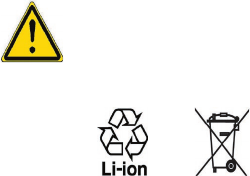
5
SAFETY PRECAUTIONS FOR POWER SUPPLY UNIT
• Use the correct external power source
A product should be operated only from the type of power source indicated
on the electrical ratings label. If you are not sure of the type of power source
required, consult your authorized service provider or local power company. For a
product that operates from battery power or other sources, refer to the operating
instructions that are included with the product.
• Handle battery packs carefully
This product contains a Li-ion battery. There is a risk of fire and burns if the battery
pack is handled improperly. Do not attempt to open or service the battery pack.
Do not disassemble, crush, puncture, short external contacts or circuits, dispose of
in fire or water, or expose a battery pack to temperatures higher than 60˚C (140˚F).
WARNING: Danger of explosion if battery is incorrectly replaced. To
reduce risk of fire or burns, do not disassemble, crush, puncture, short
external contacts, expose to temperature above 60° C (140° F), or
dispose of in fire or water. Replace only with specified batteries. Recycle
or dispose of used batteries according to the local regulations or
reference guide supplied with your product.
• Take extra precautions
• Keep the battery or device dry and away from water or any liquid as it may
cause a short circuit.
• Keep metal objects away so they don’t come in contact with the battery or
its connectors as it may lead to short circuit during operation.
• Do not use a battery that appears damaged, deformed, or discolored, or the
one that has any rust on its casing, overheats, or emits a foul odor.
• Always keep the battery out of the reach of babies and small children, to
avoid swallowing of the battery. Consult the doctor immediately if the
battery is swallowed.
• If the battery leaks:
• Do not allow the leaking fluid to come in contact with skin or clothing. If
already in contact, flush the affected area immediately with clean water
and seek medical advice.
6
• Do not allow the leaking fluid to come in contact with eyes. If already
in contact, DO NOT rub; rinse with clean water immediately and seek
medical advice.
• Take extra precautions to keep a leaking battery away from fire as there
is a danger of ignition or explosion.
• Communicate the appropriate steps immediately in case a hazard occurs.
SAFETY PRECAUTIONS FOR DIRECT SUNLIGHT
Keep this product away from excessive moisture and extreme temperatures. Do not
leave the product or its battery inside a vehicle or in places where the temperature
may exceed 60°C (140°F), such as on a car dashboard, window sill, or behind a glass
that is exposed to direct sunlight or strong ultraviolet light for extended periods of
time. This may damage the product, overheat the battery, or pose a risk to the vehicle.
PREVENTION OF HEARING LOSS
CAUTION: Permanent hearing loss may occur if earphones or headphones are used at
high volume for prolonged periods of time.
SAFETY IN AIRCRAFTS
Due to the possible interference caused by this product to an aircraft’s navigation
system and its communications network, using this device’s phone function on board
an airplane is against the law in most countries. If you want to use this device when on
board an aircraft, remember to turn off the phone by switching to Flight Mode.
ENVIRONMENT RESTRICTIONS
Do not use this product in gas stations, fuel depots, chemical plants or where blasting
operations are in progress, or in potentially explosive atmospheres such as fuelling
areas, fuel storehouses, below deck on boats, fuel or chemical transfer or storage
facilities, and areas where the air contains chemicals or particles, such as grain, dust, or
metal powders. Please be aware that sparks in such areas could cause an explosion or
fire resulting in bodily injury or even death.
EXPLOSIVE ATMOSPHERES
When in any area with a potentially explosive atmosphere or where flammable
materials exist, the product should be turned off and the user should obey all signs
and instructions. Sparks in such areas could cause an explosion or fire resulting in
bodily injury or even death. Users are advised not to use the equipment at refueling
points such as service or gas stations, and are reminded of the need to observe
restrictions on the use of radio equipment in fuel depots, chemical plants, or where
blasting operations are in progress. Areas with a potentially explosive atmosphere
are often, but not always, clearly marked. These include fueling areas, below deck on
boats, fuel or chemical transfer or storage facilities, and areas where the air contains
chemicals or particles, such as grain, dust, or metal powders.
7
ROAD SAFETY
Vehicle drivers in motion are not permitted to use telephony services with handheld
devices, except in the case of emergency. In some countries, using hands-free devices
as an alternative is allowed.
SAFETY PRECAUTIONS FOR RF EXPOSURE
• Avoid using your device near metal structures (for example, the steel frame of a
building).
• Avoid using your device near strong electromagnetic sources, such as microwave
ovens, sound speakers, TV and radio.
• Use only original manufacturer-approved accessories, or accessories that do not
contain any metal.
• Use of non-original manufacturer-approved accessories may violate your local RF
exposure guidelines and should be avoided.
INTERFERENCE WITH MEDICAL EQUIPMENT FUNCTIONS
This product may cause medical equipment to malfunction. The use of this device is
forbidden in most hospitals and medical clinics.
If you use any other personal medical device, consult the manufacturer of your device
to determine if it is adequately shielded from external RF energy. Your physician may
be able to assist you in obtaining this information.
Turn the phone OFF in health care facilities when any regulations posted in these areas
instruct you to do so. Hospitals or health care facilities may be using equipment that
could be sensitive to external RF energy.
HEARING AIDS
Some digital wireless phones may interfere with some hearing aids. In the event of
such interference, you may want to consult your service provider, or call the customer
service line to discuss alternatives.
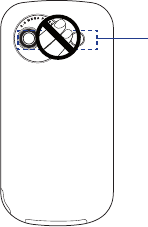
8
NONIONIZING RADIATION
Your device has an internal antenna. This product should be operated in its normal-use
position to ensure the radiative performance and safety of the interference. As with
other mobile radio transmitting equipment, users are advised that for satisfactory
operation of the equipment and for the safety of personnel, it is recommended that no
part of the human body be allowed to come too close to the antenna during operation
of the equipment.
Use only the supplied integral antenna. Use of unauthorized or modified antennas may
impair call quality and damage the phone, causing loss of performance and SAR levels
exceeding the recommended limits as well as result in non-compliance with local
regulatory requirements in your country.
Internal
antenna
location
To assure optimal phone performance
and ensure human exposure to RF energy
is within the guidelines set forth in the
relevant standards, always use your device
only in its normal-use position. Do not touch
or hold the antenna area unnecessarily
when placing or receiving a phone call.
Contact with the antenna area may impair
call quality and cause your device to operate
at a higher power level than needed.
Avoiding contact with the antenna area
when the phone is IN USE optimizes the
antenna performance and the battery life.
9
General Precautions
• Avoid applying excessive pressure to the device
Do not put heavy objects or apply excessive pressure on the device to prevent
damaging the device or distorting the touch screen display. Also avoid carrying the
device inside your pocket for extensive lengths of time.
• Heed service markings
Except as explained elsewhere in the Operating or Service documentation, do
not service any product yourself. Service needed on components inside these
compartments should be done by an authorized service technician or provider.
• Damage requiring service
Unplug the product from the electrical outlet and refer servicing to an authorized
service technician or provider under the following conditions:
• Liquid has been spilled or an object has fallen into the product.
• The product has been exposed to rain or water.
• The product has been dropped or damaged.
• There are noticeable signs of overheating.
• The product does not operate normally when you follow the operating
instructions.
• Avoid hot areas
The product should be placed away from heat sources such as radiators, heat
registers, stoves, or other products (including, but limited to, amplifiers) that produce
heat.
• Avoid wet areas
Never use the product in a wet location.
• Avoid using your device after a dramatic change in temperature
When you move your device between environments with very different temperature
and/or humidity ranges, condensation may form on or within the device. To avoid
damaging the device, allow sufficient time for the moisture to evaporate before
using the device.
NOTICE: When taking the device from low-temperature conditions into a
warmer environment or from high-temperature conditions into a cooler
environment, allow the device to acclimate to room temperature before
turning on power.
• Avoid pushing objects into product
Never push objects of any kind into cabinet slots or other openings in the product.
Slots and openings are provided for ventilation. These openings must not be blocked
or covered.
10
• Mounting accessories
Do not use the product on an unstable table, cart, stand, tripod, or bracket. Any
mounting of the product should follow the manufacturer’s instructions, and should
use a mounting accessory recommended by the manufacturer.
• Avoid unstable mounting
Do not place the product with an unstable base.
• Use product with approved equipment
This product should be used only with personal computers and options identified as
suitable for use with your equipment.
• Adjust the volume
Turn down the volume before using headphones or other audio devices.
• Cleaning
Unplug the product from the wall outlet before cleaning. Do not use liquid cleaners
or aerosol cleaners. Use a damp cloth for cleaning, but NEVER use water to clean the
LCD screen.
11
Contents
Chapter 1 Getting Started 15
1.1 Getting to Know Your Device and Accessories ..................................16
1.2 Installing the SIM Card, Battery, and Storage Card ..........................20
1.3 Starting Up ..........................................................................................23
1.4 The Today Screen .................................................................................26
1.5 The Start Menu ....................................................................................27
1.6 Quick Menu ..........................................................................................28
1.7 QuickTasks ...........................................................................................28
1.8 HTC Home™ ..........................................................................................29
1.9 TouchFLO™ ...........................................................................................34
1.10 Status Icons ........................................................................................41
1.11 Programs ............................................................................................43
1.12 Settings ...............................................................................................46
Chapter 2 Entering and Searching Information 51
2.1 Entering Information ...........................................................................52
2.2 Using the 16-key Keypad .....................................................................54
2.3 Using the Onscreen Keyboard ............................................................56
2.4 Using Touch Keyboard .........................................................................56
2.5 Using Touch Keypad ............................................................................57
2.6 Using Symbol Pad ................................................................................58
2.7 Using Letter Recognizer ......................................................................59
2.8 Using Block Recognizer .......................................................................60
2.9 Using Transcriber .................................................................................60
2.10 Searching Information ......................................................................61
12
Chapter 3 Using Phone Features 63
3.1 Using the Phone ...................................................................................64
3.2 Making a Call ........................................................................................66
3.3 Receiving a Call ....................................................................................69
3.4 Making a Video Call .............................................................................72
3.5 Receiving a Video Call ..........................................................................76
3.6 Smart Dial .............................................................................................76
3.7 Additional Dialing Information ..........................................................78
3.8 Setting Up Bluetooth SIM Access for Car Kit Phones ........................78
Chapter 4 Setting Up Your Device 81
4.1 Basic Settings .......................................................................................82
4.2 Personalizing the Today Screen ..........................................................85
4.3 Protecting Your Device ........................................................................87
Chapter 5 Synchronizing Information With Your Computer 89
5.1 About Synchronization .......................................................................90
5.2 Setting Up Windows Mobile® Device Center on Windows Vista™ ....91
5.3 Setting Up ActiveSync® on Windows XP® ..........................................93
5.4 Synchronizing With Your Computer ...................................................94
5.5 Synchronizing via Bluetooth ..............................................................95
5.6 Synchronizing Music and Video .........................................................96
Chapter 6 Organizing Contacts, Appointments, Tasks,
and Other Information 97
6.1 Contacts ................................................................................................98
6.2 SIM Manager ......................................................................................102
6.3 Calendar .............................................................................................104
6.4 Tasks ....................................................................................................107
6.5 Notes ...................................................................................................109
6.6 Voice Recorder ....................................................................................111
13
Chapter 7 Exchanging Messages 113
7.1 Messaging ..........................................................................................114
7.2 Text Messages ....................................................................................115
7.3 MMS ....................................................................................................117
7.4 Types of E-mail Accounts ..................................................................121
7.5 E-mail Setup Wizard ..........................................................................122
7.6 Using E-mail .......................................................................................125
Chapter 8 Working With Company E-mails and Meeting
Appointments 131
8.1 Synchronizing Your Device with the Exchange Server ...................132
8.2 Working With Company E-mails .......................................................133
8.3 Managing Meeting Requests ...........................................................137
8.4 Finding Contacts in the Company Directory ...................................139
Chapter 9 Working With Documents and Files 141
9.1 Microsoft® Office Mobile ...................................................................142
9.2 Adobe® Reader® LE ............................................................................143
9.3 Copying and Managing Files .............................................................144
9.4 ZIP .......................................................................................................145
9.5 Backing Up Data ................................................................................146
Chapter 10 Getting Connected 149
10.1 Comm Manager ................................................................................150
10.2 Connection Setup ............................................................................151
10.3 Ways of Connecting to the Internet ................................................152
10.4 GPRS/3G ...........................................................................................152
10.5 Dial-up ..............................................................................................154
10.6 Starting a Data Connection .............................................................154
10.7 Internet Explorer® Mobile ...............................................................155
10.8 Windows Live™ .................................................................................157
10.9 Using Your Device as a Modem (Internet Sharing) ........................161
10.10 Bluetooth .......................................................................................163
14
Chapter 11 Experiencing Multimedia 171
11.1 Camera ..............................................................................................172
11.2 Camera Album .................................................................................183
11.3 Pictures & Videos .............................................................................187
11.4 Windows Media® Player Mobile ......................................................189
11.5 Streaming Media .............................................................................194
11.6 Flash Lite Player ...............................................................................196
11.7 Audio Manager ................................................................................197
11.8 Audio Booster ..................................................................................201
Chapter 12 Managing Your Device 205
12.1 Adding and Removing Programs ...................................................206
12.2 Using Task Manager .........................................................................206
12.3 Resetting Your Device ......................................................................208
12.4 Managing Memory ..........................................................................210
12.5 Windows Update ..............................................................................211
12.6 Battery Saving Tips ..........................................................................212
Chapter 13 Using Other Applications 213
13.1 Voice Speed Dial ..............................................................................214
13.2 Java ...................................................................................................216
13.3 Spb GPRS Monitor ...........................................................................218
Appendix 221
A.1 Specifications .....................................................................................222
A.2 Regulatory Notices ............................................................................225
Index 231

Chapter 1
Getting Started
1.1 Getting to Know Your Device and Accessories
1.2 Installing the SIM Card, Battery,
and Storage Card
1.3 Starting Up
1.4 The Today Screen
1.5 The Start Menu
1.6 Quick Menu
1.7 QuickTasks
1.8 HTC Home™
1.9 TouchFLO™
1.10 Status Icons
1.11 Programs
1.12 Settings
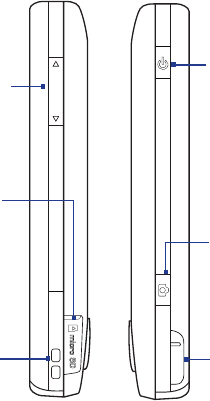
16 Getting Started
1.1 Getting to Know Your Device and Accessories
Left panel
Volume Buttons
• Press the top or bottom
to adjust the speaker
volume.
• During a call, press the top
or bottom to adjust the
earpiece volume.
microSD Slot
See "Installing a
Storage Card" for
details.
Lanyard/Strap holder
Right panel
POWER
Press to turn off the
display temporarily.
To turn off the power,
press and hold for
about 5 seconds. For
more information, see
“Starting Up” in this
chapter.
Stylus
CAMERA
Press to launch the
Camera. See Chapter
11 for details.
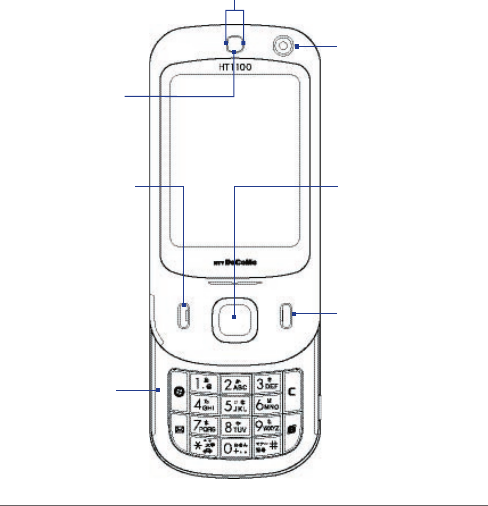
Getting Started 17
Front panel
Notification LEDs
* See description below.
Earpiece
Listen to a phone
call from here.
Touch Screen
TALK
Press to answer an
incoming call or dial a
number.
NAVIGATION CONTROL/
ENTER
Press this multi-directional
control up, down, left, or
right to move through menus
and program instructions;
carry out the selection by
pressing the center button.
END
Press to end a call or to
return to the Today screen.
Press and hold to open the
Quick List where you can
choose an action to do.
In the Quick List, touch
Settings (or tap Start >
Settings > System tab >
Long Press End Key) to set
the behavior when pressing
and holding the END key.
Second Camera
Use this camera for video call
conversations.
16-key keypad
Slide up the front
panel of the device to
reveal the keypad. Use
to dial phone numbers,
enter information, or
to open the associated
application.
* Right LED: Shows Green and Amber lights for HSDPA/UMTS/GSM/GPRS/EDGE
standby, message, and network status as well as for notification and
battery charging status.
Left LED: Shows a flashing Blue light when the Bluetooth system is powered up and
ready to transmit Bluetooth radio signal.
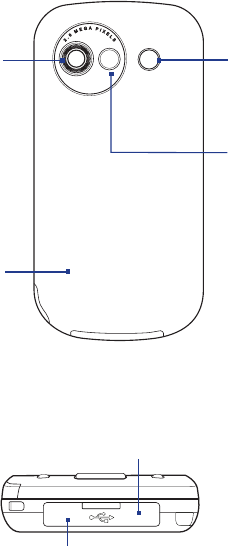
18 Getting Started
Back panel
Speaker
2 Megapixel
Camera
See Chapter 11
for details.
Back Cover
Remove to install
the SIM card and
battery.
Self-portrait Mirror
Use it when taking self-
portrait shots.
Bottom panel
RESET
Open the rubber cover to access the reset button. With the
stylus, press the RESET button to soft-reset your device.
Sync Connector/Earphone Jack/AC adapter connector
Open the rubber cover to connect the supplied USB cable to
synchronize information or plug in the AC adapter to recharge the
battery. You can also connect the supplied USB stereo headset for
hands-free conversation or for listening to audio media.
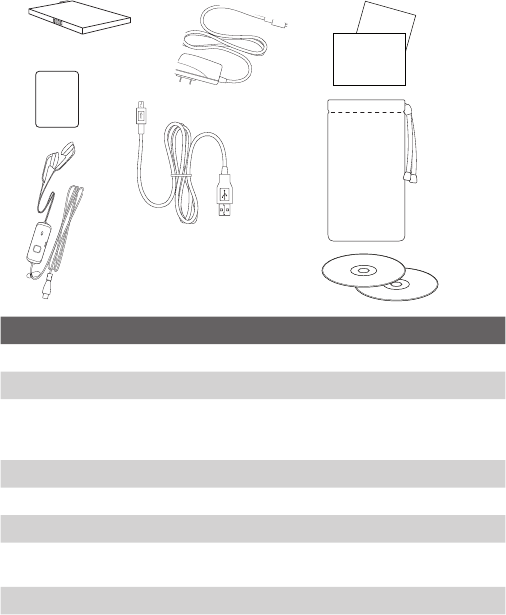
Getting Started 19
Accessories
9
1
5
4 7
User Manual
Read Me First
3
8
Screen
Protector
2
6
No. Accessory Function
1 Battery Insert into the device before turning it on.
2 Screen protector Stick on the touch screen to prevent scratches.
3 Stereo headset Provides a volume control slider and a Send/End button.
Press the Send/End button to pick up a call or put a call
on hold; press and hold the button to end the call.
4 AC adapter Recharges the battery.
5 USB sync cable Connects your device to a PC and synchronizes data.
6 Stylus Use to tap items onscreen.
7 User manual and
ReadMeFirst
Use a reference when using your device.
8 Pouch Acts as a protective carrying case for your device.
9 Getting Started
disc and
Applications disc
Source for additional tools and programs.
20 Getting Started
1.2 Installing the SIM Card, Battery, and
Storage Card
Always turn off your device before installing or removing the SIM card or
battery.
The SIM card contains your phone number, service details, and phonebook/
message memory. Your device supports both 1.8V and 3V SIM cards. Some
legacy SIM cards will not function with your device. You should consult with
your service provider for a replacement SIM card. There may be fees for this
service.
Your device contains a rechargeable Li-ion battery. It is designed to use
only manufacturer-specified original batteries and accessories. Battery
performance depends on many factors, including network configuration,
signal strength, the temperature of the environment in which you operate
your device, the features and/or settings you select and use, items attached
to connecting ports, and your voice, data, and other program usage
patterns.
Battery life estimates (approximations):
• Standby time: Up to 135+ hours for GSM
Up to 268 hours for UMTS
(Subject to network and phone usage)
• Talk time: Up to 4.75 hours for GSM.
Up to 3.15 hours for UMTS.
(Subject to network and phone usage)
• Media playback time: Up to 8 hours for WMV;
Up to 12 hours for WMA.
Warning! To reduce risk of fire or burns:
• Do not attempt to open, disassemble, or service the battery pack.
• Do not crush, puncture, short external contacts, or dispose of in fire
or water.
• Do not expose to temperatures above 60oC (140oF).
• Replace only with the battery pack designated for this product.
• Recycle or dispose of used battery as stipulated by local regulation.
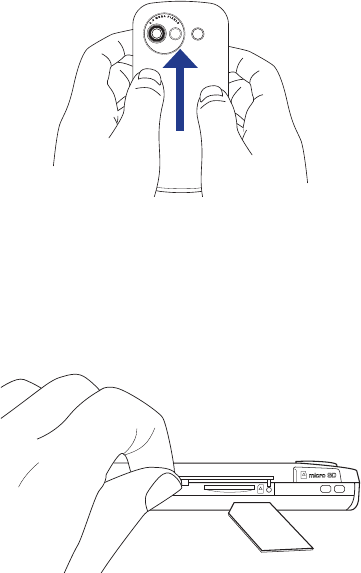
Getting Started 21
To remove the back cover
Before installing the SIM card or battery, you have to remove the back cover.
1. Make sure your device is turned off.
2. Slide the back cover upward as shown in the following illustration.
To install the SIM card
1. Use your thumb or finger to pry open the cover that houses the SIM
card slot. To open the slot cover easier, pry it open from both ends.
2. Hold open the slot cover with one hand.
3. Insert the SIM card with its gold contacts facing down and its cut-off
corner facing toward the inside of the slot.
4. Close the slot cover.
SIM
Note To remove the SIM card, press it to pop it out of the slot.
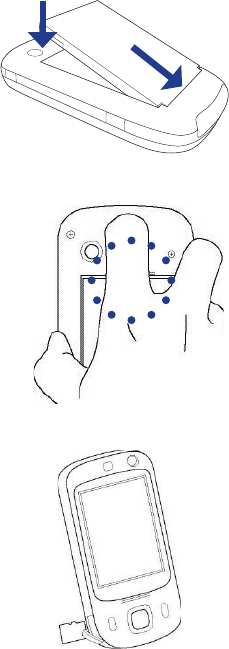
22 Getting Started
To install the battery
Install the battery by inserting
it with its exposed copper part
aligned with the protruding copper
conductor on the lower-left side of
the battery compartment.
Insert the bottom side of the
battery first, then gently push the
battery into place.
To remove the battery
1. Make sure your device is turned off.
2. Remove the back cover.
3. To remove the battery, lift it up
from the top end of the battery.
To install the microSD™ card
1. Pry open the rubber cover at the
bottom-left side of the device.
2. Insert the microSD card with the
gold contacts facing up.
3. Close the rubber cover.
Tip Press the microSD card to pop it
out of the slot.
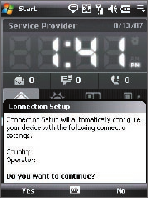
Getting Started 23
1.3 Starting Up
After inserting your SIM card and battery, you can now power on and start
using your device.
Turn your device on and off
To turn on the power
• Press and hold the POWER button for a few seconds.
When you turn on your device for the first time, a Quick Start Wizard
will guide you through the calibration process and the setup of
regional settings, date and time, and password. For more information
about touch screen calibration, see “Calibrate the device”.
To turn off the power
• Press and hold the POWER button for a few seconds.
A message will then be displayed, prompting you whether or not to
turn off the device completely.
Auto configure the data connection settings
The first time you power on your device, you will see a notification message
from the Connection Setup on the Today screen.
The Connection Setup can automatically configure your device’s data
connections, such as GPRS, WAP, and MMS, for you so that you do not need
to enter the settings manually onto your device.

24 Getting Started
To automatically configure data connection settings
1. When you see the notification message from the Connection Setup,
tap Yes.
Notes • If you do not see the notification message, tap on the title bar to
display the message.
• If your SIM card supports multiple network operator profiles, a
message will appear with network profile choices. Select the profile
you want to use and tap OK.
2. Connection Setup then starts to configure your device’s data
connection settings.
3. After the Connection Setup completes the configuration, tap Restart.
For more information about the Connection Setup, see Chapter 10.
Charge the battery
New batteries are shipped partially charged. Before you start using your
device, it is recommended that you charge the battery. Some batteries
perform best after several full charge/discharge cycles. You can charge the
battery in two ways:
•
Charging the device’s battery by connecting the power adapter.
• Connecting your device to a PC via the provided USB Sync cable.
Note Only the AC adapter and USB cable provided with your device should be
used to charge the device.
Charging is indicated by a solid amber light on the right LED indicator.
As the battery is being charged while the device’s power is on, a charging
icon ( ) will be shown on the title bar of the Today screen. After the
battery has been fully charged, the right LED becomes green and a full
battery icon ( ) appears on the Today screen’s title bar.
Warning! • Do not remove the battery from the device while you are charging it
using the AC or car adapter.
• As a safety precaution, the battery stops charging when it overheats.
Getting Started 25
Calibrate the device
Calibrating the touch screen involves tapping the center of a cross with the
stylus as the cross moves around the screen. This process ensures that when
you tap the screen with your stylus, the tapped item is activated.
If your device does not accurately respond to screen taps, follow these steps
to re-calibrate it:
1. Tap Start > Settings > System tab > Screen.
2. On the General tab, tap Align Screen, then follow the onscreen
instructions to complete the calibration.
Manage screen settings
The device’s display has the following orientation modes: Portrait and
Landscape. To change the orientation, tap Start > Settings > System tab >
Screen, and select the orientation you want.
Tip To quickly change the screen orientation, you can also tap the Rotate Screen
icon in HTC Home’s Launcher. See “HTC Home” later in this chapter for details.
To smooth the edges of screen fonts for many programs, on the ClearType
tab, select the Enable ClearType check box.
To increase the readability or to see more content on the screen, on the
Text Size tab, adjust the text size by moving the slider.
Switch your device to Sleep mode
Quickly pressing the POWER button turns off the display temporarily and
switches your device to Sleep mode. Sleep mode suspends your device to a
low power state while the display is off in order to save battery power.
Your device also automatically goes into Sleep mode when you leave the
device idle after a certain amount of time.
To specify the timeout period before your device goes into Sleep mode
1. Tap Start > Settings > System tab > Power > Advanced tab.
2. Under On battery power, make sure the Turn off device if not used
for check box is selected.
3. Select the battery timeout period, then tap OK.
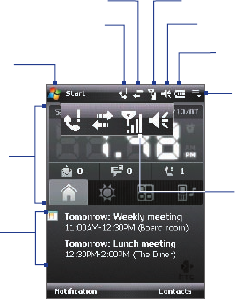
26 Getting Started
You will still be able to receive messages and calls while your device is in
Sleep mode. Pressing the POWER button again or new incoming calls/
messages will wake up your device.
1.4 The Today Screen
The Today screen displays important information, such as upcoming
appointments and status indicators. You can touch or tap a section on the
screen to open the associated program.
Your upcoming
appointments
Open Start Menu
Notification
Signal strength
Adjust volume
Battery status
HTC Home
(See “HTC Home”
in this chapter
for details)
Open Quick Menu
(See “Quick Menu” in
this chapter for details)
Connection status
Enlarged Title Bar
See third bulleted item
below
• To access the Today screen, tap Start > Today.
• To customize the Today screen display, including the background
image, tap Start > Settings > Personal tab > Today.
• Touch the area in the Title bar where the icons are to show the
enlarged title bar. In the enlarged Title bar, touch the item to activate
it. The enlarged Title bar is available in all screens.
For more information about customizing the Today screen, see Chapter 4.
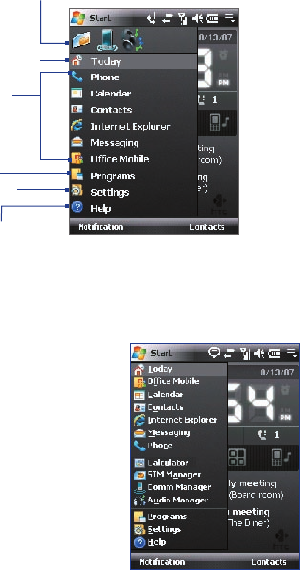
Getting Started 27
1.5 The Start Menu
The Start menu, located at the top left corner of the Today screen, displays a
list of programs. You can start a program by scrolling through the programs
list and then pressing ENTER, or by tapping a program with the stylus.
View Help information for the
current screen.
View and change settings.
Access more programs.
Open a recently-used program.
Open a program.
(The items displayed in the
Start menu can be customized
by tapping Start > Settings >
Personal tab > Menus).
Switch to the Today screen.
Disable Large Start Menu
By default, the Start menu is set to Large. You can choose to set the Start
menu size to normal.
To disable the large Start Menu
1. Tap Start > Settings > Personal
tab > Large Start Menu.
2. Clear the Enable large Start menu
check box.
3. Tap OK.
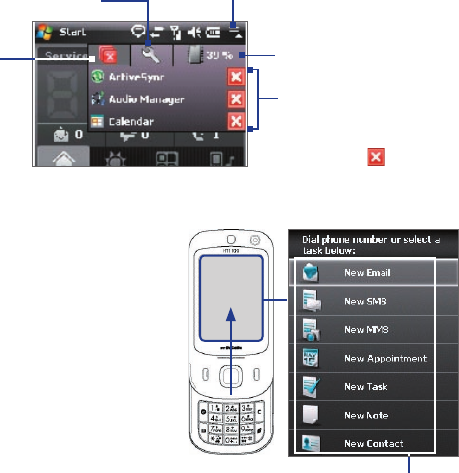
28 Getting Started
1.6 Quick Menu
The Quick Menu, located at the top right corner of the Today screen, shows
the currently running programs. You can quickly switch between running
programs, stop programs, and see how much program memory is being
used.
Tap this button to open
the Quick Menu.
• To switch to a running
program, tap the
program name.
• To stop running a
program, tap .
Customize how programs
are closed. (See “Using Task
Manager” in Chapter 12.)
Stop all
currently
running
programs.
Shows the total program
memory usage (in
percentage). Tap to open
Memory settings.
1.7 QuickTasks
QuickTasks lets you quickly
access frequently-used tasks
by simply opening the front
panel of the device.
The QuickTasks only opens
when you open the keyboard
while on the Today screen.
You can disable the Quick
Tasks by tapping Start >
Settings > System tab
> Keypad QuickTasks
and clearing the Enable
QuickTasks when keypad is
opened check box.
Touch to activate the item
Note QuickTasks will not open when the screen orientation is in Landscape mode.
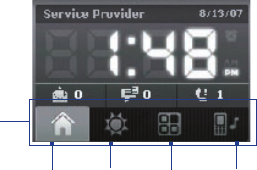
Getting Started 29
1.8 HTC Home™
HTC Home™ is a Today screen plug-in that gives you up-to-date local
information at a glance, such as time, day and weather information, and
shows new messages and missed calls. It also has a customizable launcher
where you can add your favorite applications for one-touch access and a
Profile selector where you can quickly change the profile or ring tone of
your device.
HTC Home has four components: Home, Weather, Launcher and Sounds.
At the bottom of HTC Home, there is a toolbar that allows you to switch
between these components.
HTC Home
Toolbar
Home Weather Launcher Sounds
To switch between the different components of HTC Home
Do any of the following:
• Touch the tabs in the toolbar using your finger.
• Tap the tabs in the toolbar using the stylus.
• Use the NAVIGATION CONTROL. If the toolbar is not selected, press
NAVIGATION up/down first to select the toolbar. Press NAVIGATION
left/right to select a tab and then press ENTER.
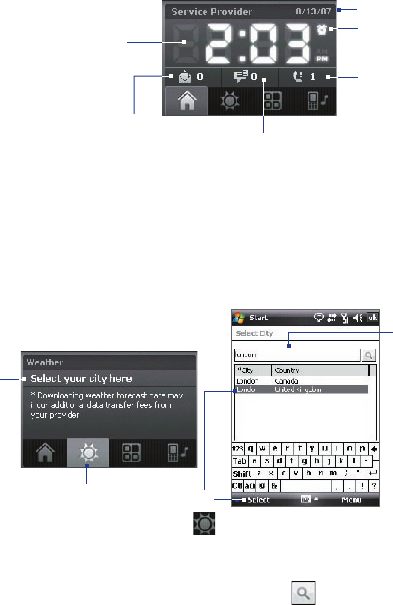
30 Getting Started
Home
Home displays the current day, date and local time. When you have new
incoming messages and calls, it shows you the number of new e-mails,
SMS/MMS messages, and missed calls. If you have set up the alarm, it also
shows the Alarm icon.
Number of new e-mails.
Touch this icon to view
your e-mails.
Number of new SMS/MMS messages.
Touch this icon to view your SMS and MMS messages.
Alarm icon
Number of missed calls.
Touch this icon to view
the Call History.
Time display.
Touch this display area
when you want to
change the date or time,
or to enable the alarm.
Current day and date
Weather
Weather shows you the current weather as well as weather information of
the next four days of the week. The first time you use this feature, you need
to select your city first to get the weather information of your city.
To select your city
2
1
3
4
1. Select the Weather tab ( ).
2. Tap the area that shows Select your city here.
3. On the Select City screen, type in the city name whose weather
information you want to track, then tap .
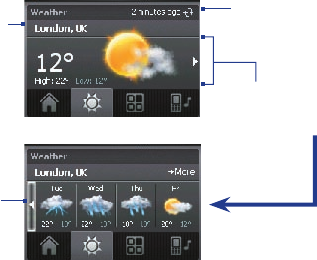
Getting Started 31
Tip You can also browse through the list of cities to choose your city.
4. Select the city on the list and tap Select.
To view weather information
After selecting your city, your device automatically connects to the Internet
via GPRS/3G and downloads weather information of the current day and
the next four days of the week. The current temperature, the highest and
lowest temperatures, and a visual indicator of the climate (showing if it’s a
cloudy or rainy day, etc.) will be displayed in the Weather tab.
Weather for the next 4 days
Tap this area
to return to
the current
day’s weather.
Current day’s weather
Tap this area to view
weather information of the
next four days of the week.
Tap this area
if you want to
select another
city.
Shows the time or days that have
passed since the last download
of weather information. Tap this
item to download the latest
weather data.
Note If you have not connected to the Internet and downloaded weather
information for five days, the following error message will be displayed:
"Unable to retrieve data for selected city. Select here to retry." Use GPRS/3G
to connect your device to the Internet, then tap the area that shows the error
message to download weather data.
To customize weather settings
1. Tap the area that shows the city name.
2. On the Select City screen, select Menu > Weather Options.
3. You can enable or disable the following options:
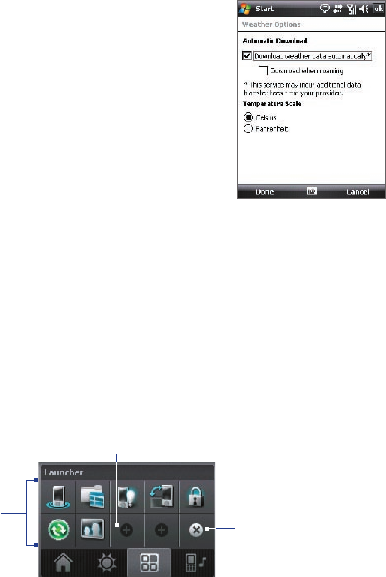
32 Getting Started
• Download weather data automatically. When this check box is
selected, weather information will automatically be downloaded from the
AccuWeather Web site whenever you select the Weather tab, if the data
has not been updated within the last three hours. Weather data will also be
downloaded every time an ActiveSync connection occurs (through over-
the-air or USB connection).
Clear this check box if you prefer
to manually download weather
information.
• Download when roaming. Select
this check box only if want to allow
automatic download of weather data
when you’re roaming. This may incur
additional costs.
• Temperature Scale. Choose
whether to display temperature in
Celsius or Fahrenheit.
Tip To check for more detailed weather information on the AccuWeather Web
site, select Menu > About Weather on the Select City screen and then tap
the link that shows AccuWeather.com. Internet Explorer Mobile then opens
and brings you to the AccuWeather Web site.
Launcher
Launcher allows you to add quick shortcuts to your favorite programs and
settings for one-touch access. Quick settings such as Adjust Backlight,
Rotate Screen and Lock Device, and a few program shortcuts are added by
default. They can be replaced with your preferred settings and programs.
Remove shortcuts
Touch a quick
shortcut to open
the associated
program or apply
the associated
setting.
Touch an empty slot to add
a shortcut to a setting or
your favorite program.
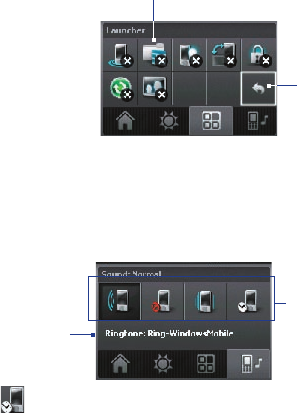
Getting Started 33
Touch a shortcut to remove it.
Return
Note To replace a shortcut, you need to delete it first and then add a shortcut to
your favorite program or setting.
Sound
Sound lets you quickly set the device volume and change the ring tone of
your device.
Tap a button to set the
device volume.
Tap to open the
phone sound
settings.
Tap to set the device volume to Automatic. If Automatic is selected,
the device will vibrate during a scheduled event in your calendar; when
there is no scheduled event in your calendar, the device will use the Normal
mode settings.
Note To learn more about setting device volume, see Chapter 3.
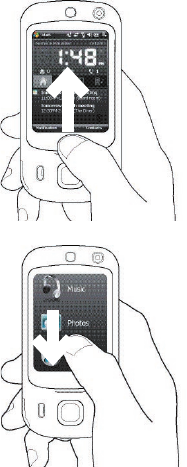
34 Getting Started
1.9 TouchFLO™
TouchFLO™ is a special feature that gives you better touch panel
experience on your device. With TouchFLO, you can simply use your finger
to scroll and pan the screen.
TouchFLO also features the Touch Cube where you can launch messaging
programs, Internet Explorer® Mobile, and more. You can also add your
favorite contacts, play music, and access your pictures and videos.
Note Touch Cube is displayed in portrait view only. To be able to open Touch Cube,
make sure your display is set to portrait mode.
Touch Cube
To open the Touch Cube
• Slide your finger upward, starting from
the bottom of the touch screen where it
shows a logo image.
To close the Touch Cube
• To close the Touch Cube and return to
the screen prior to opening the Touch
Cube, slide your finger downward on
the touch screen.
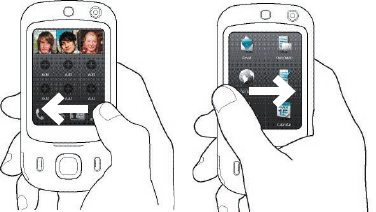
Getting Started 35
To navigate the Touch Cube
The Touch Cube is a three-dimensional, cubic user interface. To flip the
interface from one side to another, slide your finger left or right on the
touch screen.
Touch Cube screens
There are three sides to the Touch Cube interface:
• On the first side of the interface, you can add up to nine favorite
contacts. If you make calls or send messages to certain people
frequently, you can add them as favorite contacts for quicker access.
Note You should already have contacts created or synchronized on your
device before you can add them as favorite contacts. SIM contacts
cannot be added as favorite contacts.
For more information about creating contacts, see Chapter 6.
For more information about synchronizing your device with the PC,
see Chapter 5. For information about synchronizing your device with
the Exchange Server, see Chapter 8.
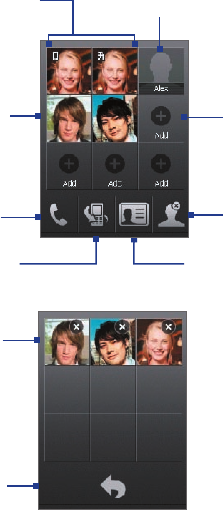
36 Getting Started
Select an empty slot
to add a favorite
contact. If the
contact has more
than one contact
number, select
the number to call
when you touch the
contact.
Open Call History.
(See Chapter 3 for details.)
Tap to call the
number associated
with the contact.
Open the Phone
program.
(See Chapter 3 for
details.)
Delete favorite
contacts.
Open Contacts.
(See Chapter 6 for details)
When you add a favorite
contact and there is no photo
associated to that contact, the
contact’s first name (or last
name) will be displayed.
When you have different
phone numbers assigned
to the same contact, an
icon appears on the top
left corner of the contact
square to tell you which
number is assigned to the
particular square.
Select a favorite
contact to remove it.
Return to your
list of favorite
contacts.
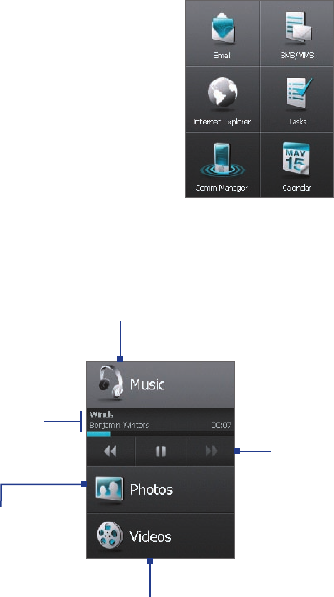
Getting Started 37
• The second side of the interface
provides quick shortcuts to your
e-mail messages, text and MMS
messages, the Internet, and
other applications.
Simply touch the icons
on the screen to open the
corresponding program.
• On the third side of the interface, you can play back music and access
the images and video files on your device.
Touch this icon to open Audio Manager and
play back music files (For more information
about using Audio Manager, see Chapter 11.)
Touch these buttons
to control music
playback.
From left to right:
Backward, Play/
Pause, Forward
While playback is in
progress in Audio
Manager, return to this
screen. You will then
see playback controls
and the music title,
artist, and remaining
playback time of the
current music.
Open Camera Album for
still images.
(See Chapter 11 for
details.)
Open Camera Album for
videos.
(See Chapter 11 for details.)
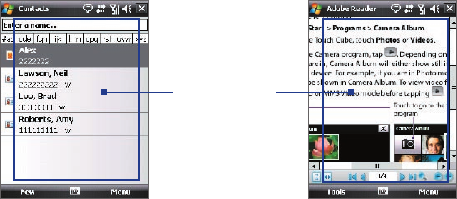
38 Getting Started
Finger scrolling and finger panning
With TouchFLO, you can use finger scrolling and finger panning when
viewing content that cannot be fit entirely on the screen, such as Web
pages, documents, and messages. Finger scrolling can also be used to scroll
up and down lists such as the contacts list, file list, message list, calendar
appointments list, and more.
Note Finger scrolling and panning works in both portrait and landscape modes.
To use finger scrolling
• Slide your finger downward to scroll up the screen.
• Slide your finger upward to scroll down the screen.
When finger
scrolling up
and down, slide
anywhere within
this area.
• To scroll towards the left, slide your finger to the right.
• To scroll towards the right, slide your finger to the left.
• While the screen is scrolling, you can stop the scrolling by pressing
your finger on the touch screen.
Note Scrollbars shown on the screen indicate that there are more content that
cannot be fit on the screen. You can finger-scroll up and down only when
there's a vertical scrollbar shown on the screen. Likewise, you can finger-
scroll left and right only when there's a horizontal scrollbar.
To use finger panning
• To pan downward, touch and hold on the touch screen then drag
your finger upward.
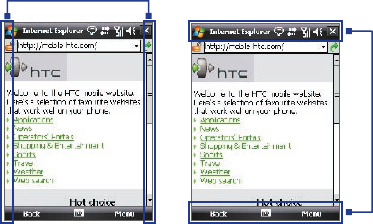
Getting Started 39
• To pan upward, touch and hold on the touch screen then drag your
finger downward.
• To pan towards the right, touch and hold on the touch screen then
drag your finger to the left.
• To pan towards the left, touch and hold on the touch screen then
drag your finger to the right.
• You can also pan diagonally.
Note Scrollbars shown on the screen indicate that there are more content that
cannot be fit on the screen. You can use finger panning only when there are
scrollbars shown on the screen.
To continuously pan
1. Drag your finger towards the boundary and hold. The Web page,
document, or message that you are viewing then continuously pans.
Left and right boundaries
Top and
bottom
boundaries
2. Release your finger to stop panning.
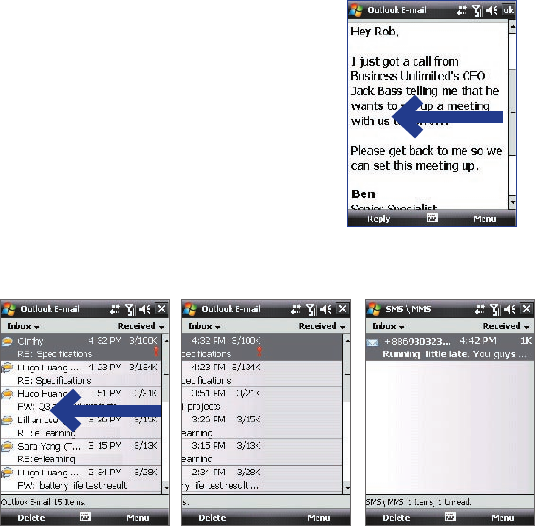
40 Getting Started
To go to the next or previous message
While reading a message, you can
slide your finger across the screen to
go to the next or previous message.
To go to the next message, slide your
finger from right to left on the screen;
To go to the previous message, slide
your finger from left to right on the
screen.
To go to the next or previous messaging account
While on a messaging account screen, you can slide your finger across the
screen to go to next or previous messaging account.
TouchFLO settings
You can enable or mute the finger scrolling and panning sound. Tap Start >
Settings > System tab > TouchFLO then select or clear the Enable sound
when finger scrolling and panning check box.
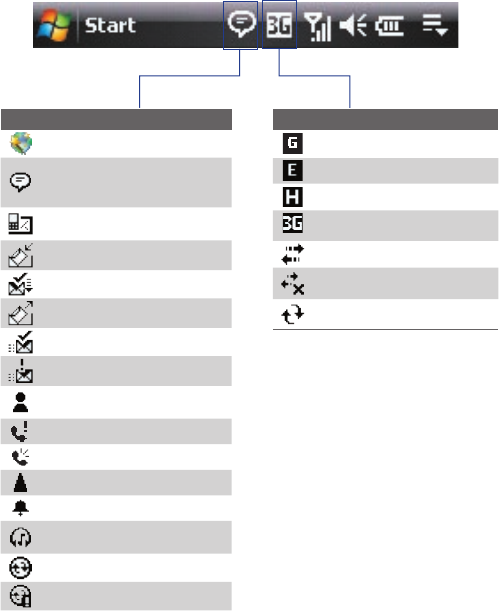
Getting Started 41
1.10 Status Icons
The following are some of the status icons that you may see on the device.
Icons that appear in this area
GPRS available
EDGE available
HSDPA available.
UMTS available.
Connection is active
Connection is not active
Synchronization in progress
Icons that appear in this area
Connection Setup
There are more notifications.
In the enlarged Title car, tap
to view all
New text messages;
SMS notification of voice mail.
Receiving MMS message
New MMS message received
Sending MMS message
MMS message sent
Cannot send MMS message
New instant message from
Live Messenger
Missed call
Speakerphone on
Roaming
Alarm
Bluetooth stereo headset
detected
ActiveSync notification
Synchronization error.
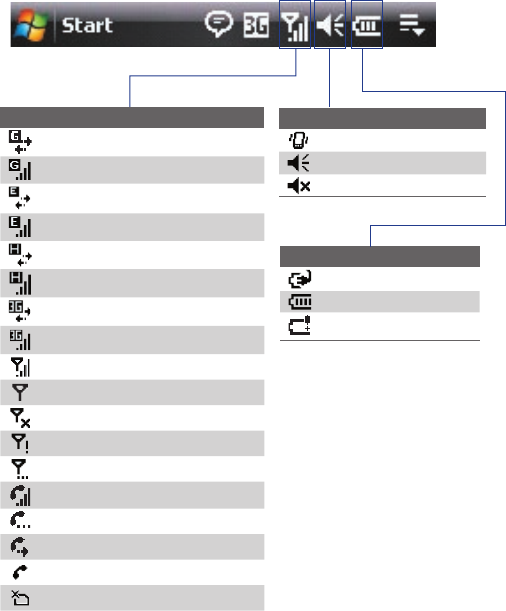
42 Getting Started
Icons that appear in this area
Vibration mode
Sound on
Sound off
Icons that appear in this area
GPRS connecting
GPRS in use
EDGE connecting
EDGE in use
HSDPA connecting.
HSDPA in use.
UMTS connecting.
UMTS in use.
Maximum signal strength
No signal
Phone is turned off
No phone service.
Searching for phone service
Voice call in progress
Call on hold
Calls are forwarded
Dialing while no SIM card is inserted
No SIM card inserted
Icons that appear in this area
Battery charging
Battery full
Battery very low
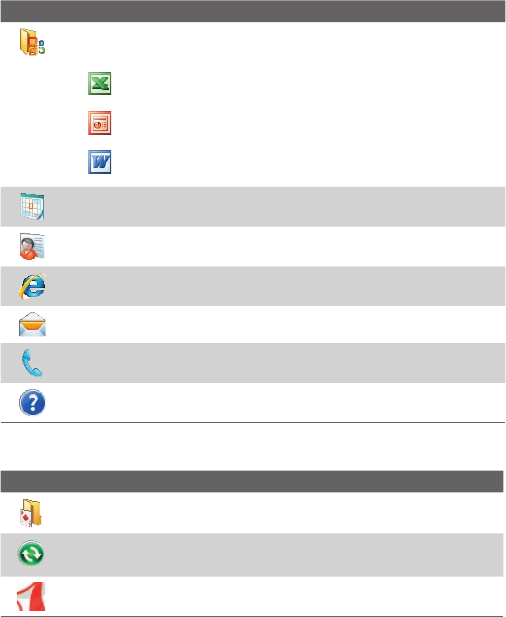
Getting Started 43
1.11 Programs
The following are programs that are preinstalled on your device.
Programs in the Start Menu
Icon Description
Office Mobile Use the complete suite of Microsoft® Office applications
for your mobile device.
Excel Mobile Create new workbooks or view and edit
Microsoft® Office Excel® workbooks.
PowerPoint Mobile View Microsoft® Office PowerPoint® slides
and presentations.
Word Mobile Create, view, and edit Microsoft® Office Word
documents.
Calendar Keep track of your appointments and create meeting
requests.
Contacts Keep track of your friends and colleagues.
Internet Explorer Mobile Browse Web and WAP sites as well as
download new programs and files from the Internet.
Messaging Send and receive e-mail, MMS, and text messages.
Phone Make and receive calls, switch between calls, and set up
conference calling.
Help See Help topics for the current screen or program.
Programs screen
Icon Description
Games Play two pre-installed games: Bubble Breaker and Solitaire.
ActiveSync Synchronize information between your device and a PC or
the Exchange Server.
Adobe Reader LE View PDF (Portable Document Format) files on your
device.
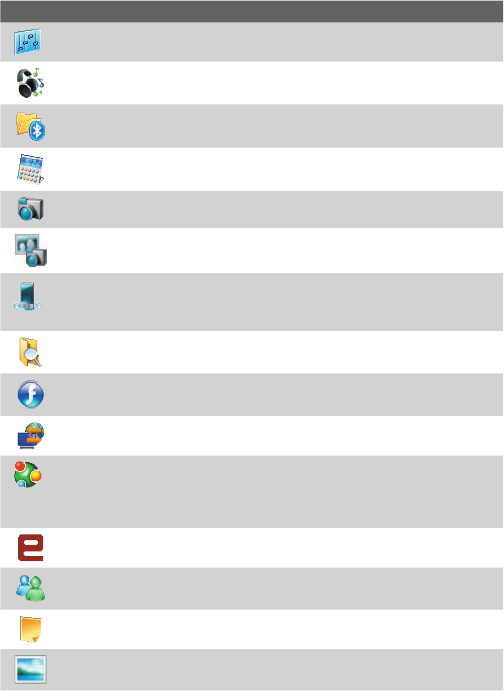
44 Getting Started
Icon Description
Audio Booster Enhances your music experience by providing you with
controls for adjusting equalizer, 3D sound, treble, and bass settings.
Audio Manager Browse and play back music files.
Bluetooth Explorer Search for other Bluetooth devices that have file
sharing enabled and access their Bluetooth shared folder.
Calculator Perform basic arithmetic and calculations, such as addition,
subtraction, multiplication, and division.
Camera Take photos or shoots video clips with accompanying audio.
Camera Album View photos that you captured using the device's
camera.
Comm Manager Manage your device’s connections (including GPRS/3G,
Bluetooth, and ActiveSync), turn the phone on or off, switch to ringer/
vibration mode, enable or disable the Direct Push function, and more.
File Explorer Organize and manage files on your device.
Flash Lite Player Play back Flash Lite™ files on your device.
Internet Sharing Connect your computer to the Internet using your
device's data connection.
Spb GPRS Monitor You will find this program in the provided disc. You
can install and use this program to measure the amount of data transfers
that you have made via the GPRS/3G or GSM network connection, and
calculate network usage costs. See Chapter 13 for details.
Java Download and install Java applications, such as games and tools,
on your device.
Messenger Use this mobile version of Windows Live Messenger to send
and receive instant messages on your device.
Notes Create handwritten or typed notes, drawings, and voice
recordings.
Pictures & Videos View, organize, and sort pictures, animated GIFs, and
video files on your device or a storage card.
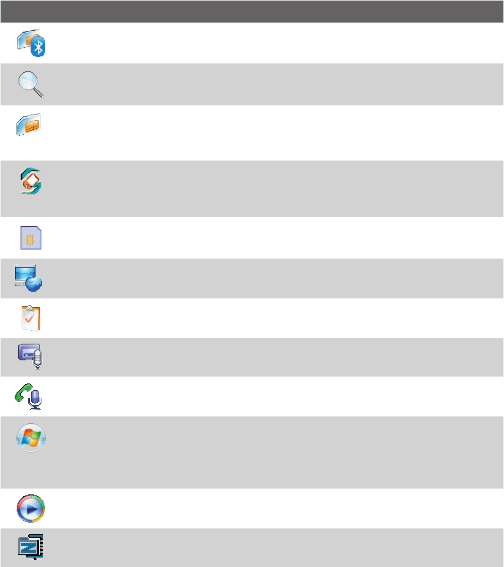
Getting Started 45
Icon Description
SAPSettings Enable Bluetooth Remote SIM access on your device.
Search Search contacts, data, and other information on your device.
SIM Manager Manage the contacts that are stored on your SIM card.
You can also use this program to copy SIM contents to Contacts on your
device.
Sprite Backup You will find this program in the provided disc. You can
install and use this program to back up your data and files. See Chapter
9 for details.
STK (SIM Tool Kit) Service Access information and other services
offered by your wireless service provider.
Streaming Media Stream live or on-demand video.
Tasks Keep track of your tasks.
Voice Recorder Record your voice, play it back, then send it via e-mail,
MMS or beaming. You can also set the recorded voice as your ring tone.
Voice Speed Dial Record voice tags so that you can dial a phone
number or launch programs simply by speaking a word.
Windows Live Use this mobile version of Windows Live™ to find
information on the Web. It also lets you sign into your Windows Live
account so that you can access your Live Mail messages and send/receive
instant messages in Live Messenger.
Windows Media Player Mobile Play back audio and video files.
ZIP Save memory and free up storage space on your device by
compressing files in the conventional ZIP format.
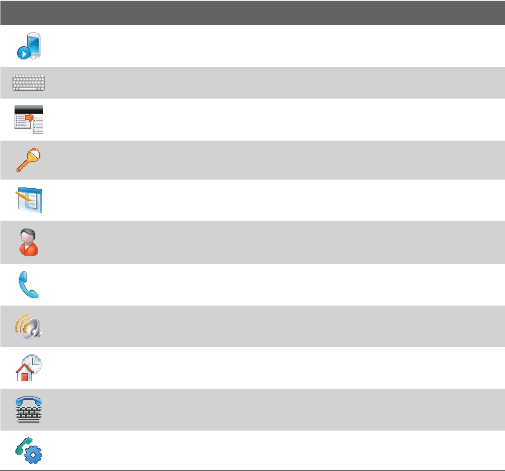
46 Getting Started
1.12 Settings
You can adjust the device settings to suit the way you work. To see all
available settings, tap Start > Settings, then tap the Personal, System, and
Connections tabs located at the bottom of the screen.
Personal tab
Icon Description
Buttons Assign a program or function to a hardware button.
Input Set options for each of the input methods.
Large Start Menu Enable or disable the large Start menu.
Lock Set a password for your device.
Menus Set what programs will appear in the Start menu.
Owner Information Enter your personal information on your device.
Phone Customize phone settings such as ring tone, set a PIN number for
your SIM card, and more.
Sounds & Notifications Enable sounds for events, notifications, and
more, and set the type of notification for different events.
Today Customize the appearance and the information to be displayed
on the Today screen.
TTY Enable TTY (Teletypewriter) support for your device.
Voice Speed Dial Create voice tags for voice dialing contacts and SIM
contacts as well as for launching programs.
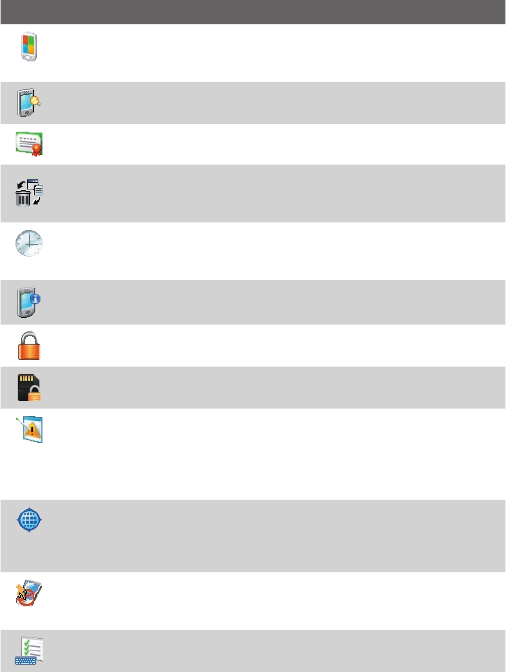
Getting Started 47
System tab
Icon Description
About This is where you can see basic information such as the Windows
Mobile® version and type of processor used on your device. You can also
specify a name for your device.
Backlight Set the backlight timeout and adjust brightness.
Certificates See information about certificates that are installed on your
device.
Clear Storage Tap this icon only when you need to remove all your
data and files from the memory and reset your device to factory default
settings.
Clock & Alarms Set the device clock to the date and time of your locale
or to a visiting time zone when you’re traveling. Alarms can also be set at
specified days and times of a week.
Device Information See information about the firmware version,
hardware, identity, and the duration of calls made on your device.
Device Lock Select the Enable auto device lock check box to
automatically lock the device when the backlight turns off.
Encryption Allow files on your storage card to be encrypted. Encrypted
files will be readable only on your device.
Error Reporting Enable or disable the device's error reporting function.
When this function is enabled and a program error occurs, technical data
about the state of the program and your computer will be logged in a
text file and delivered to Microsoft's technical support if you choose to
send it.
External GPS Set the appropriate GPS communication ports, if required.
You may need to do this when there are programs on your device that
access GPS data or you have connected a GPS receiver to your device.
See Help for details.
Key Lock Lock the buttons on your device except for the POWER button
when the device is in Sleep mode. This ensures you will not switch the
device on by accident and consume unnecessary power.
Keypad QuickTasks Enable or Disable the QuickTasks when you open
the front panel of the device.
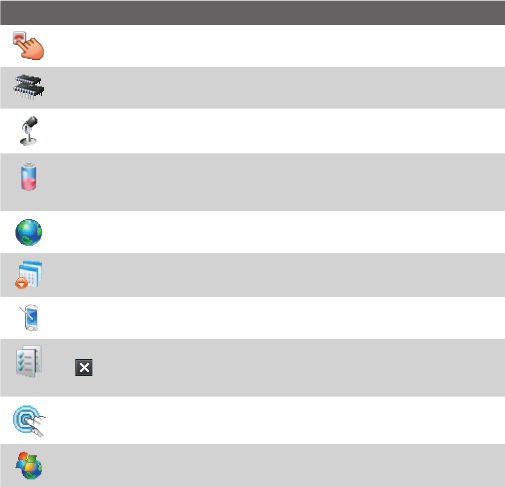
48 Getting Started
Icon Description
Long Press End Key Lets you set the behavior when you press and hold
the END key.
Memory Check the device memory allocation status and memory card
information. You can also stop currently running programs.
Microphone AGC Adjust the volume of your voice automatically when
you are recording.
Power Check the remaining battery power. You can also set the timeout
for turning off the display (switching device to Sleep mode) to conserve
battery power.
Regional Settings Set the regional configuration to use, including the
format for displaying numbers, currency, date, and time on your device.
Remove Programs Remove programs that you installed on your device.
Screen Change the screen orientation, re-calibrate the screen, and
change the screen text size.
Task Manager Stop running programs and set the Exit button
( ) to end programs immediately when you tap the button. For more
information, see "Task Manager" in Chapter 12.
TouchFLO You can enable or mute the finger scrolling and panning
sound. See "TouchFLO settings" in this chapter for details.
Windows Update Update Windows Mobile® on your device with the
latest updates, security patches or fixes, if they are available.
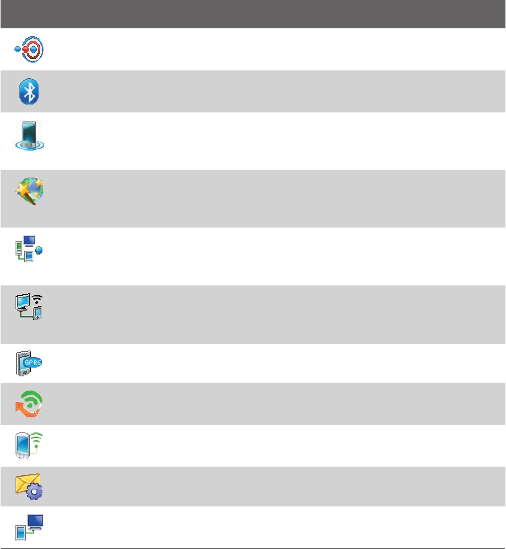
Getting Started 49
Connections tab
Icon Description
Beam Set your device to receive incoming Bluetooth beams.
Bluetooth Turn Bluetooth on, set your device to visible mode, and scan
for other Bluetooth devices.
Comm Manager Manage your device’s connections (including GPRS/3G,
Bluetooth, and ActiveSync), turn the phone on or off, switch to ringer/
vibration mode, enable or disable the Direct Push function, and more.
Connection Setup Configure your device’s data connections, such
as GPRS, WAP, and MMS, based on the detected or selected network
operator. See Chapter 10 for details.
Connections Set up one or more types of modem connections for your
device, such as phone dial-up, GPRS, and more, so that your device can
connect to the Internet or a private local network.
CSD Line Type Set the line type to use when making a circuit switch
data (CSD) connection. Normally, you do not need to change the setting
unless you encounter a problem on establishing a connection.
GPRS Setting Set the GPRS authentication method.
HSDPA Turn on or off HSDPA. Your wireless service provider must
support this feature to be able to turn it on.
Network Cards Set up your device's network card.
SMS Service Set your device to send SMS text messages via a data
connection, such as GPRS or a circuit-switched connection.
USB to PC Set a USB serial connection between your device and PC
when there are problems connecting ActiveSync.
50 Getting Started

Chapter 2
Entering and Searching
Information
2.1 Entering Information
2.2 Using the 20-key QWERTY Hardware Keyboard
2.3 Using the Onscreen Keyboard
2.4 Using Touch Keyboard
2.5 Using Touch Keypad
2.6 Using Symbol Pad
2.7 Using Letter Recognizer
2.8 Using Block Recognizer
2.9 Using Transcriber
2.10 Searching Information
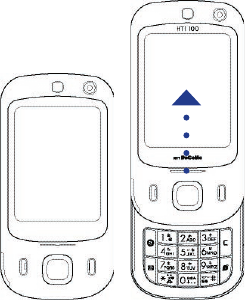
52 Entering and Searching Information
2.1 Entering Information
When you start a program or select a field that requires text or numbers,
you can either use the 16-key keypad or the onscreen keyboard to enter
information.
16-key Keypad
To reveal the 16-key keypad, slide up the front panel of the device.
Slide up the front panel
Tip When dialing phone numbers, use the 16-key keypad.
Onscreen keyboard
When you start a program or select a field that requires text or numbers, the
Input Panel icon becomes available on the menu bar.
Tap the Input Selector arrow (that appears next to the Input Panel icon)
to open a menu where you can select a text input method and customize
input options. After selecting a text input method, the corresponding Input
Panel is then displayed and you can use it to enter text. To toggle between
showing and hiding the Input Panel, simply tap the Input Panel icon.
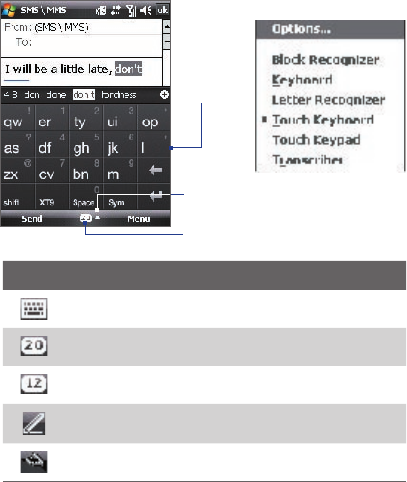
Entering and Searching Information 53
Input Panel
(Touch
Keyboard)
Input Selector
arrow
Input Panel icon
Icon Input method
Onscreen Keyboard
Touch Keyboard
Touch Keypad
Letter Recognizer or Block Recognizer
Transcriber
Note Some text input methods may not be available in certain language versions
of the device.
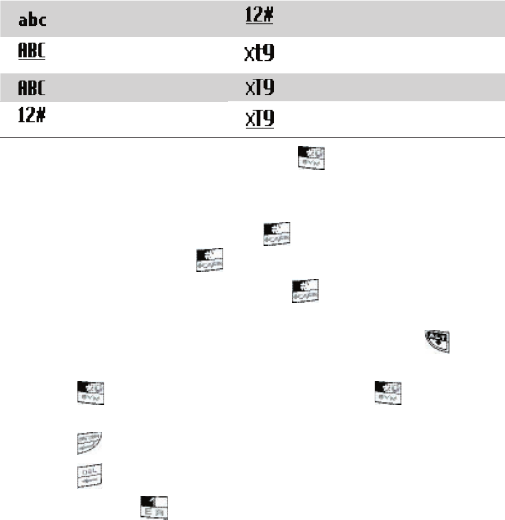
54 Entering and Searching Information
2.2 Using the 16-key Keypad
You can enter text, numbers, and symbols by using the 16-key keypad.
When you select a field that requires entering text or numbers, the phone
automatically selects the appropriate input mode. The status indicator on
the top of the display screen shows the input mode that you are currently
using.
Input modes
Lowercase text input Numeric or symbol (labeled in blue
color) input, locked
Uppercase text input, caps
lock XT9 text input mode, lowercase
Uppercase text input
XT9 text input mode, uppercase
Numeric or symbol (labeled
in brown color) input XT9 text input mode, caps lock
To change the input method, press and hold and select the input
method you want to use on the menu.
You can do the following with the 20-key QWERTY keyboard:
• To use all uppercase letters, press twice. To change back to all
lowercase letters, press again.
• To use a single uppercase letter, press and then press the
corresponding key.
• To enter a number or symbol (labeled in blue color), press and
then press the corresponding key.
• Press to open the Symbol pad. Press and hold to open the
input menu.
• Press to insert a hard return.
• Press to delete the previous character.
• Press and hold to access your voicemail.

Entering and Searching Information 55
Multipress mode
In Multipress mode, you enter a character by pressing the key on which the
character appears.
To enter text in Multipress mode
• To enter the first character, press once. To enter the second character,
press twice, and so on.
• To enter character that are on the same key, wait for the highlight on
the character to disappear before you press the key again.
XT9 mode
To form a word in XT9 mode, press the keys that contain the letters you
want. As you enter letters, XT9 analyzes your keypresses and attempts
to complete the word. XT9 also tries to predict your next word based on
previous sentences you have type.
To enter text in XT9 mode
1. Press and hold the key.
2. On the menu, select XT9 English.
To change XT9 settings, press and hold and on the menu, select XT9
Settings.
Tip To type in all uppercase letters, press the key twice.
While typing, words will appear at the bottom of the screen. Use the
NAVIGATION CONTROL to choose the word you want to insert and press
ENTER.
Numeric mode
Input numbers by changing the input method to Numeric mode.
To enter numbers
1. Press and hold the key and select 123 on the menu.
2. On the keyboard, enter the number(s) you want.
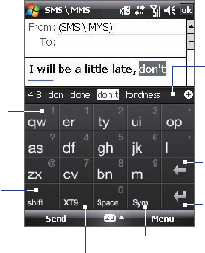
56 Entering and Searching Information
2.3 Using the Onscreen Keyboard
The onscreen Keyboard is available when text entry is possible. You can
enter text by tapping keys on the keyboard that are displayed on the screen.
To enter text using the onscreen Keyboard
1. In a program, tap the Input Selector arrow, and tap Keyboard.
2. Enter text by tapping keys on the onscreen Keyboard.
To enlarge the onscreen Keyboard
1. Tap the Input Selector arrow, then tap Options.
2. In the Input method list, select Keyboard.
3. Tap Large keys.
2.4 Using Touch Keyboard
The Touch Keyboard is an onscreen keyboard layout similar to the 20-key
hardware keyboard of your device. With the enlarged keys and input
enhancement, you can type faster and more accurately using the Touch
Keyboard.
Tap to enter
letters or symbols.
Tap and hold to
immediately enter
the symbol on top
of the key.
Tap to enter
uppercase letters;
Tap twice to caps
lock.
Tap to cycle through the input
methods: XT9, multitap, and numeric.
The keyboard changes to a numeric
keyboard when in the numeric mode.
Tap to open the Symbol pad.
See “Using Symbol Pad.”
Tap to create a
new line.
Tap to delete the
previous character.
Displays the word
candidate list in XT9
mode. Tap to insert
the word into the
message. Tap the
+ symbol to add a
word.
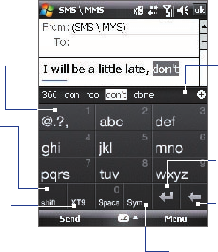
Entering and Searching Information 57
To use the Touch Keyboard
1. Start a program that accepts user input, such as Word Mobile.
2. Tap the Input Selector arrow, and tap Touch Keyboard.
3. Enter text by tapping keys on the onscreen Keyboard. The way you
enter characters using the Touch Keyboard is similar to using the
20-key keyboard, please see “Using the 20-key Hardware Keyboard”
earlier in this chapter for details.
To change Touch Keyboard and XT9 settings
1. Tap the Input Selector arrow, and tap Options.
2. In the Input Method tab, select Touch Keyboard in Input method
and tap Options.
Tip You can change the keyboard layout by changing the Language.
3. Tap XT9 Settings. On the XT9 Settings screen, select the options you
want and tap Done.
2.5 Using Touch Keypad
The Touch Keypad is an onscreen keypad layout similar to a 12-key keypad
with some additional keys. With the enlarged keys and input enhancement,
you can type faster and more accurately using the Touch Keypad.
Tap to enter letters or
numbers. Tap and hold
to immediately enter the
number on top of the key.
Tap to enter
uppercase letters;
Tap twice to caps
lock.
Tap to cycle through
the input methods: XT9,
multitap, and numeric.
The keypad changes to a
numeric keyboard when
in the numeric mode.
Tap to open the Symbol pad.
See “Using Symbol Pad.”
Tap to create a
new line.
Tap to delete the
previous character.
Displays the word
candidate list in XT9
mode. Tap to insert
the word into the
message. Tap the
+ symbol to add a
word.
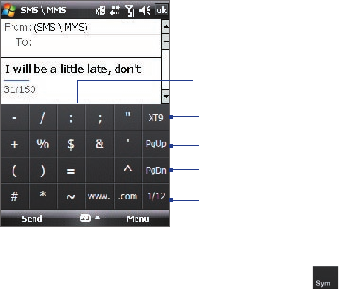
58 Entering and Searching Information
To use the Touch Keypad
1. Start a program that accepts user input, such as Word Mobile.
2. Tap the Input Selector arrow, and tap Touch Keypad.
3. Enter text by tapping keys on the onscreen keypad. See “Multipress
mode”, “XT9 mode”, and “Numeric mode” to learn how to enter
characters.
To change Touch Keypad and XT9 settings
Refer to “To change Touch Keyboard and XT9 settings.” Select Touch Keypad
instead of Touch Keyboard in Input method.
2.6 Using Symbol Pad
Symbol Pad provides a comprehensive list of common symbols such as
parentheses, braces, currency signs, and more, as well as punctuation
marks and special characters. The Symbol pad is available for both Touch
Keyboard and Touch Keypad.
Tap a symbol to insert it into the message.
Tap to display the previous page of symbols.
Tap to display the next page of symbols.
Tap to close the Symbol Pad without
selecting any symbol.
Indicates the current page and the total
number of symbol pages. Tap to go to the
next page of symbols.
To open the Symbol Pad
While using Touch Keyboard or Touch Keypad, tap .
Entering and Searching Information 59
To change Symbol Pad settings
1. Tap the Input Selector arrow, and tap Options.
2. In the Input Method tab, select Touch Keyboard in Input method
and tap Options.
3. Select the Turn on one-touch symbol entry check box to select only
one symbol at a time and immediately close the Symbol Pad after
your selection. To be able to select several symbols at a time, clear this
check box.
2.7 Using Letter Recognizer
With Letter Recognizer, you can write individual letters, numbers, and
punctuation, which are then converted into typed text.
To use Letter Recognizer
1. From a program, tap the Input Selector arrow, and tap Letter
Recognizer.
2. Write characters, numbers, and symbols in the designated writing
area.
• Enter Capital letters by writing in the ABC (left) area of the box.
• Enter lowercase letters by writing in the abc (middle) area of the
box.
• Enter numbers by writing in the 123 (right) area of the box.
• Enter punctuation and symbols by tapping in either area of the
box and then writing the desired character.
Note Letter Recognizer is available when text entry is possible.
Tip For help with writing characters, tap the question mark near the writing area.

60 Entering and Searching Information
2.8 Using Block Recognizer
With Block Recognizer, you use a single stroke to write letters, numbers,
symbols, and punctuation, which are then converted into typed text.
To use Block Recognizer
1. From a program, tap the Input Selector arrow, and tap Block
Recognizer.
2. Write characters, numbers, and symbols in the designated writing
area.
• Enter letters by writing in the abc (left) area of the box.
• Enter numbers by writing in the 123 (right) area of the box.
• Enter symbols and punctuation by tapping in either area of the
box and then writing the desired character.
Note Block Recognizer is available when text entry is possible.
Tip For help with writing characters with Block Recognizer, tap the question
mark near the writing area.
2.9 Using Transcriber
Transcriber is a handwriting recognition program that allows you to write
in cursive, print, or a combination of both.
To write using Transcriber
1. Start a program that accepts user input, such as Word Mobile.
2. Tap the Input Selector arrow, and tap Transcriber. The Transcriber
introductory screen appears.
3. Position the cursor where you want text to appear.
4. Use the stylus to write anywhere on the screen. The handwriting will
be converted to text shortly after you lift the stylus from the screen.
To enter punctuation and symbols
Transcriber comes with an onscreen keyboard that provides an easy way to
add punctuation or a special symbol to existing text. To use this onscreen
keyboard, tap on the Transcriber toolbar.

Entering and Searching Information 61
The keyboard remains visible until you tap the button again.
Tips • To reposition the keyboard, tap and hold the title bar, then drag to the
desired location.
• When no text is selected, you can also open the keyboard by doing the
gesture. For more information about using Transcriber gestures, see Help
on your device.
To edit text
1. In a program, draw a line across the text you want to edit.
2. After you lift the stylus from the screen, the line will disappear and the
selected text will be highlighted.
3. Do either of the following:
• Rewrite the text.
• Use gestures to capitalize letters, insert a space, and so on. For
information about using Transcriber gestures, see Help on your
device.
2.10 Searching Information
You can search for files and other items stored in My Documents folder or
on an installed storage card of your device. You can search by file name
or by words located in the item. For example, you can search in e-mail
messages, notes, appointments, contacts, and tasks, as well as in online
Help.
To search for a file or an item
1. Tap Start > Programs > Search.
2. In the Search for field, you can:
• Enter the file name, word, or other information you want to search
for.
• Tap the down arrow icon ( ), and from the list, select one item
that you have looked for before.
3. In the Type field, you can tap the down arrow icon ( ) and select a
data type from the list to help narrow your search.

62 Entering and Searching Information
4. Tap Search. The system then starts searching the matched files in the
My Documents folder and subfolders.
5. In the Results list, tap the item you want to open.
Note The storage card symbol ( or ) is displayed next to the names of files
saved on a storage card.

Chapter 3
Using Phone Features
3.1 Using the Phone
3.2 Making a Call
3.3 Receiving a Call
3.4 Making a Video Call
3.5 Receiving a Video Call
3.6 Smart Dial
3.7 Additional Dialing Information
3.8 Setting Up Bluetooth SIM Access
for Car Kit Phones
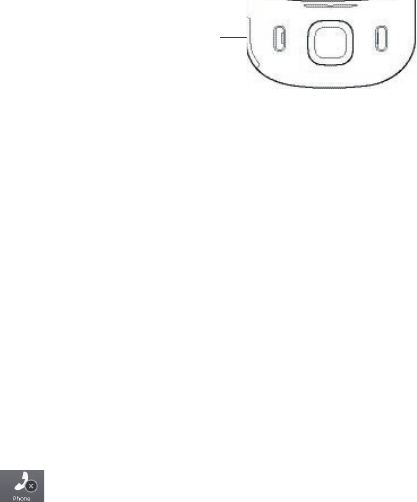
64 Using Phone Features
3.1 Using the Phone
Like a standard mobile phone, you can use your device to make, receive,
and keep track of calls and send messages. You can also dial directly
from Contacts, and easily copy phonebook entries from your SIM card to
Contacts on your device.
The Phone screen
From the Phone screen, you can access Call History, Speed Dial, and Phone
settings. To open the Phone screen, do one of the following:
• Tap Start > Phone.
• Press the TALK button.
• While on the Today screen,
open the keyboard and
then press a numeric key.
TALK
button
Enter your PIN
Most SIM cards are preset with a PIN (personal identification number) that is
provided by your wireless service provider.
1. Enter the preset PIN assigned by your wireless service provider.
2. Tap Enter.
Note If your PIN is entered incorrectly three times, the SIM card will be blocked. If
this happens, you can unblock it with the PUK (PIN Unblocking Key) obtained
from your wireless service provider.
Turn the phone function on and off
In many countries, you are required by law to turn off the phone while on
board an aircraft.
To turn off the phone function
1. Tap Start > Settings > Connections tab > Comm Manager.
2. On the Comm Manager screen, tap the Phone button to turn off the
phone function.
The icon indicates the phone function is turned off.
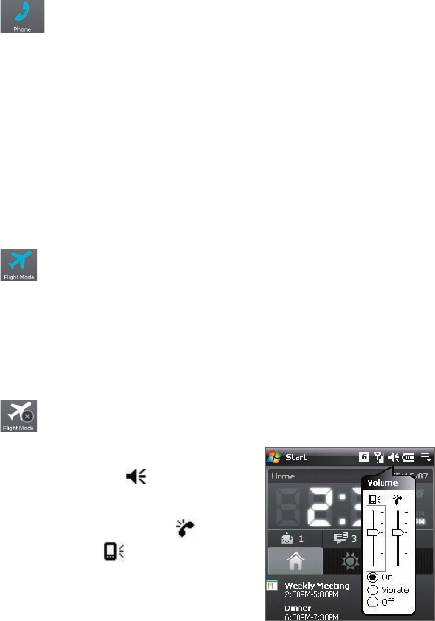
Using Phone Features 65
To resume call function
• Turn on the phone function by tapping the Phone button again on
the Comm Manager screen.
The icon indicates the phone function is turned on.
Flight mode
Another way to turn off the phone function is to switch your device to
Flight mode.
To enable Flight mode
When you enable Flight mode, it turns off all wireless radios on your device,
which include the phone function and Bluetooth.
1. Tap Start > Settings > Connections tab > Comm Manager.
2. On the Comm Manager screen, tap the Flight Mode button to enable
Flight mode.
The icon indicates that Flight mode is enabled.
To disable Flight mode
When you disable Flight mode, it turns the phone function back on. This
also restores the previous state of Bluetooth.
• Disable Flight mode by tapping the Flight Mode button again on the
Comm Manager screen.
The icon indicates that Flight mode is disabled.
Adjust the device volume
1. Tap the Speaker icon ( ).
2. Under Volume, do the following:
• Adjust the phone volume ( ) or
device volume ( ) by moving the
slider to the desired volume level.
• Tap On, Vibrate, or Off to change both
the system and ringer volume settings.
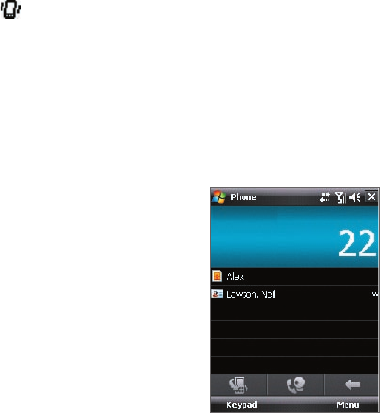
66 Using Phone Features
Notes • To adjust the conversation phone volume, you must do it during a call.
Adjusting the volume at another time will affect the ring, notification, and
MP3 sound levels.
• When you activate Vibrate mode, sound will automatically be muted and
your device will vibrate when an incoming call is received. The Vibrate
icon ( ) will appear in the title bar to indicate that Vibrate mode is
activated.
3.2 Making a Call
With your device, you can make a call from Phone, Contacts, TouchFLO,
Speed Dial, Call History, and SIM Manager.
Make a call from Phone
1. While on the Today screen, open the
keyboard of the device.
2. Start pressing the numeric keys on
the keyboard to enter the phone
number.
3. Press the TALK button on your device
to place the call.
Tip If you press a wrong number, press
XXX to erase each subsequent digit of
a number. To erase the entire number,
press and hold XXX.
Make a call from Contacts
Tap Contacts on the Today screen or tap Start > Contacts, then do one of
the following:
• Press NAVIGATION up or down to select a contact, and press TALK.
• Tap the desired contact in the contacts list, and tap the phone
number that you want to call.
• Tap and hold the desired contact, and on the shortcut menu, tap Call
Work, Call Home, or Call Mobile.
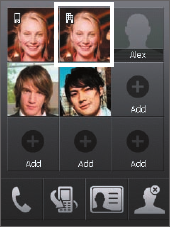
Using Phone Features 67
To choose one of the numbers of a contact to dial
By default, the mobile phone number (m) of a contact is dialed when you
make a call from Contacts. However, you can specify that a different phone
number is dialed instead.
1. Tap Start > Contacts.
2. Press NAVIGATION up or down to select the contact.
3. Press NAVIGATION left or right. The letters representing the number
will change as you scroll through them.
Make a call from TouchFLO
To place a call to a favorite contact that you added to TouchFLO’s Touch
Cube, follow these steps:
1. Open the Touch Cube by sliding your finger upward, starting from the
bottom of the touch screen where it shows a logo image.
(See Chapter 1 for detailed instructions.)
2. Slide your finger left or right to rotate the cube and navigate to the
screen where it shows your favorite contacts.
3. Touch the photo or name of the contact whom you want to call.
Tip Touch and hold the contact to open the contact's summary.

68 Using Phone Features
Make a call from Call History
1. On the Phone screen, tap the Call History button ( ).
2. Touch the tab where you want to look. The tabs represent the
different types of calls on the device. The tabs are arranged by (from
left to right): Outgoing calls, Incoming calls, Missed calls, and All calls.
3. Finger-scroll to the desired contact or phone number, and press TALK.
One-touch Speed Dial
Use Speed Dial to call frequently-used numbers with a single press. For
example, if you assign a contact to the location 2 in Speed Dial, you can
simply press and hold on the keyboard to dial the contact’s number.
Before you can create a Speed Dial entry, the number must already exist in
Contacts.
To create a Speed Dial entry
1. On the Phone screen, tap Menu > Speed Dial.
2. Tap Menu > New.
3. Tap a contact. Select the phone number that you want to add to be
assigned with a speed dial key.
4. In the Location box, select an available key to use as the speed dial
key.
Note If you want to place a phone number in a position that is already occupied,
the new number will replace the number that is already there.
Tips • To create a Speed Dial entry from Contacts or SIM card contact, tap the
contact, select the number you want to add to Speed Dial and then tap
Menu > Add to Speed Dial.
• To delete a Speed Dial entry, in the Speed Dial list, tap and hold the
desired entry, and tap Delete.
To call voicemail
The number 1 key is generally reserved for your voicemail. Tap and hold
this button on the Phone screen to call voicemail.
Using Phone Features 69
Make a call from SIM Manager
SIM Manager allows you to view the contents of your SIM card, transfer SIM
phonebook entries to Contacts on your device, and make a call from your
SIM card.
To call a SIM contact
1. Tap Start > Programs > SIM Manager. Wait for your SIM card
contents to load.
2. Tap and hold the name or phone number of the person you want to
call, and tap Call.
For more information about SIM Manager, see Chapter 6.
3.3 Receiving a Call
When you receive a phone call, a message will appear, giving you the
option to either answer or ignore the incoming call.
To answer or reject an incoming call
• To answer the call, tap Answer, or press TALK on the device.
• To reject the call, tap Ignore, or press END on the device.
• Open the keyboard.
Note For you to be able to answer calls by opening the keyboard, the Slide
keypad to answer call check box must be selected. To check, tap Start >
Settings > Personal tab > Phone > Advanced tab.
To reject a call and send a text message
When you reject a call, you can choose to automatically send a text
message to the caller.
1. On the Phone screen, tap Menu > Options > Advanced tab.
2. Select the Reject call with text message check box. Change the
default message if needed.
After enabling Reject call with text message, you can:
• Tap Send Text when you receive a call to reject the call and send a
text message to the caller.

70 Using Phone Features
• Tap Silence when you receive a call to mute the ringing sound
without rejecting the call.
Note When the Reject call with text message option is selected, you need to
press the TALK button on the device to answer calls.
To end a call
Once an incoming or outgoing call is in progress, you can tap End or press
END on the device to hang up.
To add a new phone number to your Contacts list after a call
If the number of the person who called is not in your Contacts list, you can
choose to save the number after you hang up. To enable this feature, tap
Start > Settings > Personal tab > Phone > Advanced tab and select the
Add new phone number to Contacts at end of call check box. Selecting
the checkbox will pop up a message after phone call ends to let you add
the number to your Contacts list.
To check a missed call
You will see the icon on top of the screen when you missed a call. To
check who the caller is:
• Tap the icon , then tap View; or
• On the Phone screen, tap the Call History button ( ). You can
view missed calls as well as incoming and outgoing calls in Call
History.
To set a reminder for missed calls
You can set the device to make a beeping sound every 2 minutes to remind
you of a missed call.
1. On the Phone screen, tap Menu > Options > Advanced tab.
2. Select the Enable missed call reminder sound check box
To put a call on hold
Your device notifies you when you have another incoming call, and gives
you the choice of rejecting or accepting the call. If you are already on a call
and accept the new call, you can choose to switch between the two callers,
or set up a conference call between all three parties.
1. Tap Answer to take the second call, and put the first one on hold.

Using Phone Features 71
2. To end the second call and return to the first call, tap End or press
END on the device.
To switch between two calls
Tap Swap.
To set up a conference call
1. Either put a call on hold, and dial a second number; or, accept a
second incoming call when you already have one in progress.
2. Tap Menu > Conference.
Note Not all service providers support conference calling. Contact your service
provider for details.
To turn on and off the Speakerphone
The built-in Speakerphone on your device allows you to talk hands-free or
lets other people listen to the conversation.
• During a call, tap Speaker On, or press and hold TALK until the
speakerphone turns on. The speakerphone icon ( ) appears in the
title bar.
• To turn off the speakerphone, tap Speaker Off, or press and hold
TALK again until the speakerphone turns off.
Warning! To avoid damage to your hearing, do not hold your device against your ear
when the Speakerphone is turned on.
To mute a call
You can turn off the microphone during a call, so that you can hear the
caller but the caller cannot hear you.
• During a call, tap Mute.
• When the microphone is turned off, the mute icon ( ) appears on
the screen. Tap Unmute to turn on the microphone again.

72 Using Phone Features
3.4 Making a Video Call
Your device allows you to make video calls when you are within a 3G
network coverage area. You need to use a 3G enable SIM card to make video
calls.
To make a video call
• On the Phone keypad, tap the phone number to call, then tap .
• On the Phone keypad, tap the phone number to call, then tap
Menu > Video Call to start a video call.
• From Contacts, tap and hold the desired contact, and tap Video Call.
• From Call History, tap and hold the desired phone number or contact,
and tap Video Call.
Note The other party’s image will appear on the screen about 3 to 5 seconds after
a connection is established, depending on the signal strength. The streaming
images quality may also be influenced by the signal.
When the video call is unsuccessful, a message pops up asking you if you
want to try again, make a voice call instead, or send an SMS/MMS message.
Change Video Call settings
While on a video call, you can change certain settings such as the size of the
image, brightness of the image, the camera to use, and more.
The following shows the Video Call screen and control buttons during an
ongoing call.
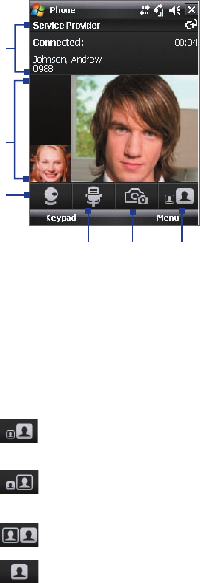
Using Phone Features 73
1Status area. Displays your service
provider name, the other party's
information, and call timer.
2Image display area. Displays your image
and the other party's image, depending
on the selected Swap Image setting.
3Camera On/Off. Tap to toggle between
turning on/off the camera. When the
camera is turned off, the image displayed
depends on the Video Call options you
have set. See “Set up Video Call Options”
for details.
4Audio Mute/Unmute. Tap to mute/
unmute audio.
5Main/Second camera. Tap to toggle
between using the Main (back) and
Second (front) camera.
6Swap Image. Tap continuously to cycle
through the available image display
options.
2
3
456
1
Swap Image options
Both parties
(My video small)
The other party's image is large while your
image is small. This is the default setting.
Both parties
(My video large)
The other party's image is small while your
image is large.
Both parties (equal)
Both your image and the other party appear
the same size.
Other party only Only the other party's image is displayed.
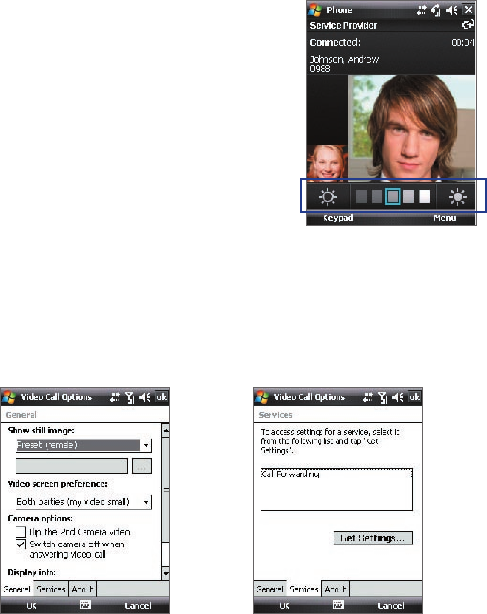
74 Using Phone Features
Adjust the brightness
You can adjust the brightness of the
device’s camera lens. To adjust the
brightness, press NAVIGATION up to
make it brighter or press NAVIGATION
down to make it less bright. When you
press NAVIGATION up or down during
a video call, a brightness bar appears at
the bottom the screen.
Brightness bar
Tips • You can also press NAVIGATION left or right to adjust the brightness.
• You can also adjust the brightness by tapping Menu > Brightness.
Set up video call options
On the Phone screen, or on the screen of the ongoing video call,
tap Menu > Video Call Options. You can set the following options:
Video Call Options: General tab Video Call Options: Services tab
Using Phone Features 75
General tab
• Show still image. Select the image you want to display when you
turn off the camera.
• Preset (female). Displays a female picture provided by your
service provider.
• Preset (male). Displays a male picture provided by your service
provider.
• Custom image. Lets you use an image from file as your display
picture. When this option is selected, the File Name box and the
Browse button will be enabled, allowing you to select an image
file.
• Last video frame. Uses the last video frame before you stopped
the camera as your display image.
• Video screen preference. To change how your image and the other
party’s image are displayed on the screen, select your preference from
the Video screen preference list or tap the Swap Image button on
the Video Call screen.
• Camera options:
• Flip the 2nd camera video. Select this check box if you are going
to show a text document to the other party using the second
camera.
• Switch camera off when answering video call. Select this check
box to not send a video feed of yourself to the other party. Instead,
the option you selected in Show still image will be displayed.
• Display info:
• Show call timer. Select this check box to display the call period in
the status area.
• Show phone number and name. Select this check box to display
the other party’s phone number and name in the status area.
Services tab
To set up further calling options for Video Call, tap the Services tab. On
the Services screen, select the desired service from the list, then tap Get
Settings to access its settings.
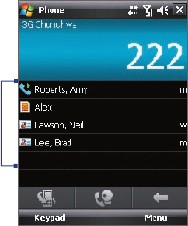
76 Using Phone Features
3.5 Receiving a Video Call
To answer or reject an incoming video call
• To answer the video call, tap Answer, or press TALK on your device.
• To reject the video call, tap Ignore, or press END on your device.
To end a video call
Once an incoming or outgoing video call is in progress, press END on the
device to hang up.
3.6 Smart Dial
Smart Dial makes it easy for you to
dial a phone number.
When you start entering a phone
number or contact name, Smart Dial
will automatically search and sort
the contact entries on the SIM card,
in Contacts, and the phone numbers
in Call History (including incoming,
outgoing, and missed calls). You can
then select the desired number or
contact from the filtered list to dial.
Smart
Dial
panel
To find a contact name or number
You can just enter the first letter of the name or number of a contact.
Smart Dial will search for contact phone numbers and the first character
of a contact name as well as from the character that appears after a space,
dash, or underscore in a contact name. For example, if you tap number “2”
on the phone keypad, which is associated with [a, b, and c] on the Phone
keypad, contact names such as the following will be considered matches:
“Ben Miller”, “George Adams”, “John-Carter”, “Carter, Ellen”, “Dixon, Allan”,
“Thomas_Clark”, “JaneCampbell”.
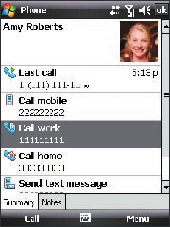
Using Phone Features 77
If the matching list is long and you want to narrow down the search further,
enter another letter. Using the same example above, if you continue to
tap “3” which is associated with [d, e, f], the matching list will be narrowed
down to the following names: “Ben Miller”, “George Adams”, “Carter, Ellen”,
“Dixon, Allan”.
Make a call or send a text message using Smart Dial
1. Press the TALK button on your device to open the Phone screen.
2. Begin entering the first few numbers or characters.
When you start entering a number or letter, the Smart Dial panel will
display matches found.
3. In the Smart Dial panel, browse the list by sliding your finger or the
stylus up or down or by pressing NAVIGATION up or down.
4. You can do one of the following:
• When the desired contact is selected, press the TALK button to
place a call.
• To send a text message to the selected contact, tap Menu > Send
Text Message.
• To call a different phone number associated with the selected
contact, press ENTER, select the phone number you want to call,
then press TALK.

78 Using Phone Features
3.7 Additional Dialing Information
Make an emergency call
• Enter the international emergency number for your locale, and press
the TALK button on your device.
Tip Additional emergency numbers may be included in your SIM card. Contact
your service provider for details.
Make an international call
1. Press and hold on the hardware keyboard (or tap and hold the
number 0 key on the phone screen) until the + sign appears.
The + replaces the international prefix of the country that you are
calling.
2. Enter the full phone number you want to dial, and press the TALK
button on your device. The full phone number includes country code,
area code (without the leading zero, if any) and phone number.
3.8 Setting Up Bluetooth SIM Access for
Car Kit Phones
Bluetooth car kits that support the SIM Access Profile (SAP) can connect to
your device and access its SIM card via Bluetooth. Once a SAP connection
has been established, you can download SIM contacts from your device to
the car kit phone. You can also use the car kit phone to answer and make
calls using your device’s SIM card.
Note To enable downloading contacts onto the car kit, ensure that all contacts
on the device are stored in the SIM card and not in the device memory.
Configure the car kit to download contacts only from the SIM card.
1. On your device, make sure that Bluetooth is turned on and set to
visible mode. For information about turning on Bluetooth and
enabling visible mode, see “Bluetooth modes” in Chapter 10.
2. Tap Start > Programs > SAPSettings.
Using Phone Features 79
3. On the BT Remote SIM Access screen, select the Remote SIM Access
check box then tap Done.
4. Connect the car kit phone to your device via Bluetooth. To learn how
to connect, consult your car kit phone’s manual.
5. If this is the first time you are pairing the car kit phone with your
device, enter the car kit’s passcode on your device.
6. A pop-up message should appear on your device saying that a
connection has been established between your device and car kit
phone. Tap OK.
7. On the BT Remote SIM Access screen, tap Done.
Note You will not be able to make/receive calls, send/receive messages or perform
related activities on your device when the SIM Access Profile connection is
active. You’ll be able to do all these from the car kit phone during this time.
After the connection is disconnected, you will be able to use your device as
before.
80 Using Phone Features

Chapter 4
Setting Up Your Device
4.1 Basic Settings
4.2 Personalizing the Today Screen
4.3 Protecting Your Device
82 Setting Up Your Device
4.1 Basic Settings
Time and date
To set the time and date
1. Tap Start > Settings > System tab > Clock & Alarms > Time tab.
2. Select the correct time zone and change the date or time.
Note During synchronization, the time on your device is updated with the time on
your PC.
To set the time and date for a different location
If you visit or communicate with someone in a particular time zone often,
you can select it as your visiting time zone.
1. Tap Start > Settings > System tab > Clock & Alarms > Time tab.
2. Tap Visiting.
3. Select the correct time zone and change the time or date.
Regional settings
The style in which numbers, currency, dates, and times are displayed is
specified in regional settings.
1. Tap Start > Settings > System tab > Regional Settings.
2. On the Region tab, select your region from the list.
Note This does not change the Operating System language of your device.
3. The region you select determines which options will be available on
the other tabs.
4. To customize settings further, tap the appropriate tabs and select the
desired options.
Display settings
To adjust screen brightness
1. Tap Start > Settings > System tab > Backlight > Brightness tab.
2. Move the slider to adjust the brightness.
Setting Up Your Device 83
To set the backlight to dim after a time delay
1. Tap Start > Settings > System tab > Backlight.
2. Tap the Battery power tab, or the External power tab.
3. Select the Turn off backlight if device is not used for check box, and
specify the time delay.
To increase or decrease the size of text on the screen
1. Tap Start > Settings > System tab > Screen > Text Size tab.
2. Move the slider to increase or decrease the text size.
Device name
The device name is used to identify your device in the following situations:
• Synchronizing with a PC
• Connecting to a network
• Restoring information from a backup
Note If you synchronize multiple devices with the same PC, each device must have
a unique name.
To change the device name
1. Tap Start > Settings > System tab > About.
2. Tap the Device ID tab.
3. Enter a name.
Note The device name must begin with a letter, consist of letters from A to
Z, numbers from 0 to 9, and cannot contain spaces. Use the underscore
character to separate words.
Ringer settings
To change the ring type and ring tone
1. On the Phone screen, tap Menu > Options > Phone tab.
2. In the Ring type list, choose whether to be notified of incoming calls
by a ring, a vibration, or a combination of both.
3. In the Ring tone list, tap the sound you want to use.

84 Setting Up Your Device
Tip You can use *.wav, *.mid, *.mp3, *.wma, or other types of sound files
that you downloaded from the Internet or copied from your PC as ring
tones. For a complete list of supported audio file formats for ring tones, see
"Specifications" in the Appendix.
To use your sound files as ring tones, copy them first to the /Windows/Rings
folder on your device, then select the sound from the Ring tone list of your
device. For more information about copying files, see Chapter 9.
Alarms and notifications
To set an alarm
1. Tap Start > Settings > System tab > Clock & Alarms > Alarms tab.
2. Tap <Description> and enter a name for the alarm.
3. Tap the day of the week for the alarm. You can select multiple days by
tapping each desired day.
4. Tap the time to open a clock and set the time for the alarm.
5. Tap the alarm icon ( ) to specify the type of alarm you want. You
can choose a flashing light, a single sound, a repeating sound, or
vibration.
6. If you choose to play a sound, tap the list next to the Play sound
check box and tap the sound you want.
To choose how to be notified about events or actions
1. Tap Start > Settings > Personal tab > Sounds & Notifications.
2. On the Sounds tab, choose how you want to be notified by selecting
the appropriate check boxes.
3. On the Notifications tab, in Event, tap an event name and choose
how you want to be notified by selecting the appropriate check
boxes. You can choose from several options, such as a special sound, a
message, or a flashing light.
Tip Turning off sounds and the flashing light helps conserve battery power.
Setting Up Your Device 85
Phone services
Your device can directly link to the mobile phone network, and allow
you to access and change the settings of various phone services for your
device. Phone services may include Call Forwarding, Call Waiting, Voicemail,
and more. Contact your wireless service provider to find out about the
availability of phone services for your device.
To access and change settings of phone services
1. Tap Start > Settings > Personal tab > Phone > Services tab.
2. Select the service you want to use, then tap Get Settings.
3. Choose your desired options, then tap OK.
For more information about customizing settings of phone services, see
Help on your device.
4.2 Personalizing the Today Screen
The Today screen shows your upcoming appointments, active tasks, and
information about incoming messages. You can customize what to display
on the Today screen.
To customize the Today screen
1. Tap Start > Settings > Personal tab > Today.
2. On the Appearance tab, select the desired theme for the background
of the Today screen.
3. On the Items tab, select the items you want to appear on the Today
screen.
To use a custom background image
You can use one of your own pictures as the background image on the
Today screen.
1. Tap Start > Settings > Personal tab > Today.
2. Select the Use this picture as the background check box, and tap
Browse to view a list of your picture files.
3. Tap the file name of the picture you want to use.
4. Tap OK.
86 Setting Up Your Device
To display owner information
Having owner information displayed on the Today screen makes it easier for
someone to return your device to you if it is lost.
1. Tap Start > Settings > Personal tab > Owner Information.
2. On the Identification tab, enter your personal information.
Tips • If you don’t see owner information on the Today screen, tap Start >
Settings > Personal tab > Today. On the Items tab, select the Owner
Info check box.
• You can set your device to display the ‘my info’ screen when your device
is turned on. This screen shows your complete personal information. To
display the 'my info' screen, tap Start > Settings > Personal tab > Owner
Information > Options tab then select the Identification information
check box.
To set options for displaying appointments on the Today screen
If you have a large number of appointments, you may want to specify the
kind of appointments that are displayed on the Today screen.
1. Tap Start > Settings > Personal tab > Today.
2. Tap the Items tab.
3. Select Calendar and tap Options.
4. Do any of the following:
• Select Next appointment to show only the next appointment
in your schedule, or Upcoming appointments to show multiple
appointments.
• Clear the Display all day events check box if you do not want to
display all-day events.
For more information about using Calendar, see Chapter 6 and 8.
To set options for displaying tasks on the Today screen
If you have a large number of tasks, you may want to specify the kind of
tasks that are displayed on the Today screen.
1. Tap Start > Settings > Personal tab > Today.
2. Tap the Items tab.
3. Select Tasks and tap Options.
Setting Up Your Device 87
4. Do any of the following:
• Under Display number of, select the type of tasks you want to
appear on the Today screen.
• In the Category list, select whether to display only tasks assigned
to a specific category or to display all tasks.
For more information about creating tasks on your device, see Chapter 6.
Customize the Start menu
You can choose which items appear in the Start menu.
1. Tap Start > Settings > Personal tab > Menus.
2. Select the check boxes of the items you want to appear in the Start
menu. You can select up to seven items.
Tip You can also create folders and shortcuts to appear on the Start menu. Using
Windows Explorer on your PC, navigate to the /Windows/Start Menu folder
of your device, then create the folders and shortcuts that you want. You will
see the added items on your device after you synchronize. For information
about synchronizing your device with the computer, see Chapter 5.
4.3 Protecting Your Device
Protect your SIM card with a PIN
You can protect your SIM card from unauthorized use by assigning a PIN
(personal identification number). The default PIN will be given to you by
your wireless service provider.
To change the PIN
1. On the Phone screen, tap Menu > Options > Phone tab.
2. Select the Require PIN when phone is used check box.
3. To change the PIN at any time, tap Change PIN.
Tip Emergency calls can be placed at any time, without requiring a PIN.
88 Setting Up Your Device
Protect your device with a password
You can help keep your data more secure by requiring a password every
time the device is turned on.
To set a device password
1. Tap Start > Settings > Personal tab > Lock.
2. Select the Prompt if device unused for check box, and in the box to
the right, select how long your device must be idle before a password
is required.
3. In the Password type box, select the type of password you would like
to use. If your device is configured to connect to a network, use an
alphanumeric password for increased security for your device.
4. Enter the password in both the Password and Confirm boxes.
5. Tap OK. The next time the device is turned on, you will be prompted
to enter your password.
Notes • To ensure you can always make emergency calls, do not begin your
password with the digits of your local emergency number.
• If you entered a hint, the hint will be displayed after the wrong password
is entered five times.
• Each time a wrong password is entered, the device response time gets
longer until the device appears to be not responding.
• If you forget your password, you can hard reset or clear the device
memory. Before you do this, make sure you back up your data and files
so that you can restore them back to your device. For more information
about hard resetting the device and clearing the memory, see Chapter 12.
Encrypt files on your storage card
You can set your device to encrypt files as they are saved on the storage
card.
1. Tap Start > Settings > System tab > Encryption.
2. Select Encrypt files placed on storage cards.
Notes • Encrypted files can be read only on the device that encrypted them.
• Encrypted files are opened just like other files, provided you are using the
device that encrypted them. There is no separate step for you to take to
read these files.

Chapter 5
Synchronizing Information
With Your Computer
5.1 About Synchronization
5.2 Setting Up Windows Mobile® Device Center on
Windows Vista™
5.3 Setting Up ActiveSync® on Windows XP®
5.4 Synchronizing With Your Computer
5.5 Synchronizing via Bluetooth
5.6 Synchronizing Music and Video
90 Synchronizing Information With Your Computer
5.1 About Synchronization
You can take information from your computer wherever you go by
synchronizing them to your device. The following types of information can
be synchronized between your computer and your device:
• Microsoft Outlook® information, which include Outlook e-mail,
contacts, calendar, tasks, and notes
• Media, such as pictures, music and video
• Favorites, which are the bookmarked links to your favorite web sites
• Files, such as documents and other files
Before you can synchronize, you need to install and set up first the
synchronization software on your computer. For more information, see
“Setting Up Windows Mobile Device Center on Windows Vista™” and
“Setting Up ActiveSync® on Windows XP®”.
Ways to synchronize
After you have installed the synchronization software to your computer,
connect and synchronize your device with your computer by using one of
the following methods:
• Connect and synchronize using the supplied USB sync cable.
Upon connecting the sync cable to your device and your computer,
the synchronization process starts automatically.
• Connect and synchronize using Bluetooth.
You must first set up a Bluetooth partnership between your device
and your computer before you can synchronize information between
them using Bluetooth. For more information about setting up
a Bluetooth partnership, see Chapter 10. For information about
synchronizing through Bluetooth, see “Synchronizing via Bluetooth”
later in this chapter.
Try to synchronize frequently in order to keep information up-to-date in
both your device and your computer.
Note You can also synchronize Outlook e-mail, contacts, calendar, and tasks on
your device with the Exchange Server at your work. For more information
about setting up your device to synchronize with the Exchange Server, see
Chapter 8.
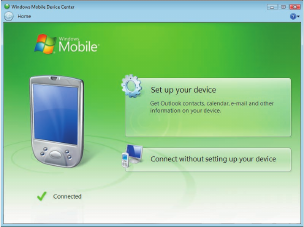
Synchronizing Information With Your Computer 91
5.2 Setting Up Windows Mobile® Device Center on
Windows Vista™
Microsoft Windows Mobile® Device Center is the replacement for
Microsoft® ActiveSync® on Windows Vista™.
Note Some versions of Windows Vista come with Windows Mobile Device Center
already installed. If Windows Mobile Device Center is not available on your
Windows Vista, you can install it from the Getting Started Disc that came with
your device.
Set up synchronization in Windows Mobile Device Center
When you connect your device to your PC and start Windows Mobile
Device Center for the first time, you are asked to create a Windows
Mobile partnership with your device. Follow the steps below to create a
partnership.
1. Connect your device to your PC. Windows Mobile Device Center
configures itself and then opens.
2. On the license agreement screen, click Accept.
3. On the Windows Mobile Device Center’s Home screen, click Set up
your device.
Note Choose Connect without setting up your device if you only want to
transfer media files, check for updates, and explore your device but not
sync Outlook information.
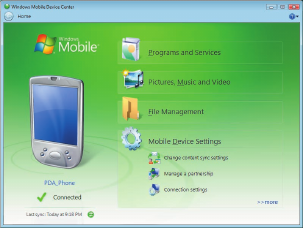
92 Synchronizing Information With Your Computer
4. Select the items you want to synchronize, then click Next.
5. Enter a device name and click Set Up.
When you finish the setup wizard, Windows Mobile Device Center
synchronizes your device automatically. Notice that Outlook e-mails and
other information will appear on your device after synchronization.
Use Windows Mobile Device Center
To open Windows Mobile Device Center, click Start > All Programs >
Windows Mobile Device Center on your Windows Vista computer.
On Windows Mobile Device Center, you can do the following:
• Click Mobile Device Settings to change synchronization settings.
• When you click Pictures, Music and Video > ___ new pictures/
video clips are available for import, a wizard guides you to tag
and transfer photos from your device to the Photo Gallery on your
Windows Vista PC.
• Click Pictures, Music and Video > Add media to your device from
Windows Media Player to synchronize music and video files using
Windows Media™ Player. For more information, see “Windows Media®
Player Mobile” in Chapter 11.
• Click File Management > Browse the contents of your device to
view documents and files from your device.
Note See Windows Mobile Device Center Help for more information.
Synchronizing Information With Your Computer 93
5.3 Setting Up ActiveSync® on Windows XP®
The Getting Started Disc that comes with your device contains Microsoft
ActiveSync 4.5 or later. Follow the steps in this section to install and set up
ActiveSync on Windows XP or other compatible Windows systems.
Note For a list of compatible Windows systems, please go to
http://www.microsoft.com/windowsmobile/activesync/activesync45.mspx.
Install ActiveSync
1. Insert the Getting Started Disc into the disc drive on your PC.
2. Click Setup and Installation.
3. Select the ActiveSync check box and click Install.
4. Read the license terms and click Accept.
5. When installation is complete, click Done.
6. On the Getting Started with Windows Mobile screen, click Close.
Set up synchronization in ActiveSync
Follow the steps below to set up a synchronization partnership.
1. Connect your device to your PC. The Synchronization Setup Wizard
automatically starts and guides you to create a synchronization
partnership. Click Next to proceed.
2. To synchronize your device with your PC, clear the Synchronize
directly with a server running Microsoft Exchange check box then
click Next.
3. Select the information types that you want to synchronize then click
Next.
4. Select or clear the Allow wireless data connections check box
according to your preference.
5. Click Finish.
When you finish the wizard, ActiveSync synchronizes your device
automatically. Notice that Outlook e-mails and other information will
appear on your device after synchronization.
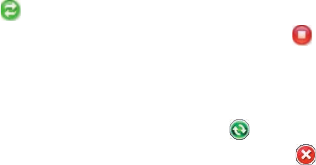
94 Synchronizing Information With Your Computer
5.4 Synchronizing With Your Computer
Connect and synchronize your device with your PC using the USB cable or
Bluetooth connection.
Start and stop synchronization
You can manually synchronize either from your device or PC.
From your device
• Tap Start > Programs > ActiveSync., then tap Sync.
To end synchronization before it completes, tap Stop.
Tip To delete a partnership with one PC completely, disconnect your device
from that PC first. In ActiveSync on your device, tap Menu > Options, tap the
computer name, then tap Delete.
From Windows Mobile Device Center
1. Click Start > All Programs > Windows Mobile Device Center.
2. Click at the lower left of the Windows Mobile Device Center.
To end synchronization before it completes, click .
From ActiveSync on your PC
When you connect your device to your PC, ActiveSync automatically opens
on your PC and synchronizes.
• To manually start synchronization, click .
• To end synchronization before it completes, click .
Change which information is synchronized
You can change the information types and the amount of information to
synchronize for each type either on your device or your PC. Follow the steps
below to change synchronization settings on your device.
Note Before changing synchronization settings on your device, disconnect it from
your PC.
1. In ActiveSync on your device, tap Menu > Options.
2. Select the check box for any items you want to synchronize. If you
cannot select a check box, you might have to clear the check box for

Synchronizing Information With Your Computer 95
the same information type elsewhere in the list.
3. To change synchronization settings for an information type, for
instance, E-mail, select it and tap Settings.
You can then set the download size limit, specify the time period of
information to download, and more.
Notes • Some information types such as Favorites, Files and Media cannot be
selected in ActiveSync Options on your device. You can only select or clear
these items from your PC’s Windows Mobile Device Center or ActiveSync.
• A PC can have sync partnerships with many different Windows Mobile
powered devices, but a device can have sync partnerships with at most
two PCs only. To ensure that your device will synchronize properly with
both PCs, set up the second PC using the same synchronization settings
you used on the first PC.
• Outlook e-mail can be synchronized with only one computer.
Troubleshoot sync connection problem
When the PC is connected to the Internet or a local network, in some cases,
the PC may disconnect the connection with your device in favor of the
Internet or network connection.
If this happens, tap Start > Settings > Connections tab > USB to PC, then
clear the Enable advanced network functionality check box. This makes
your PC utilize a serial USB connection with your device.
The USB to PC ( ) icon appears on the Today Screen when serial USB
connection is used.
5.5 Synchronizing via Bluetooth
You can connect and synchronize your device with the PC using Bluetooth.
To synchronize with a computer via Bluetooth
1. Set up Windows Mobile Device Center or ActiveSync on your PC
to synchronize through Bluetooth. See the program’s Help for
instructions.
2. On your device, tap Start > Programs > ActiveSync.
96 Synchronizing Information With Your Computer
3. Make sure that Bluetooth on both your device and the computer
are turned on and set to visible mode. For more information, see
“Bluetooth” in Chapter 10.
4. Tap Menu > Connect via Bluetooth. Make sure the Bluetooth
function of both your device and the computer are turned on and set
to visible mode.
5. If this is the first time you have connected to this computer via
Bluetooth, you must first complete the Bluetooth wizard on your
device and set up a Bluetooth partnership between your device
and the computer. For more information about creating a Bluetooth
partnership, see “Bluetooth partnerships” in Chapter 10.
Notes • To preserve battery power, turn off Bluetooth when not in use.
• To connect and synchronize your device with a computer via Bluetooth,
your computer must have built-in Bluetooth or installed with a Bluetooth
adapter or dongle.
5.6 Synchronizing Music and Video
If you want to carry your music or other digital media along with you while
you travel, set up Microsoft® Windows Media® Player on your computer to
synchronize music and video with your device.
Other than selecting the Media information type to be synchronized, all
media synchronization settings must be set in Windows Media Player.
Before media can be synchronized, you must do the following:
• Install Windows Media Player Version 11 on the PC. (Windows Media
Player 11 works only in Windows XP or later versions).
• Connect your device to the PC with a USB cable. If your device is
currently connected using Bluetooth, you must end that connection
before media can be synchronized.
• Set up a sync partnership between your device and your PC’s
Windows Media® Player.
For more information about using Windows Media® Player Mobile, see
Chapter 11.

Chapter 6
Organizing Contacts,
Appointments, Tasks, and
Other Information
6.1 Contacts
6.2 SIM Manager
6.3 Calendar
6.4 Tasks
6.5 Notes
6.6 Voice Recorder
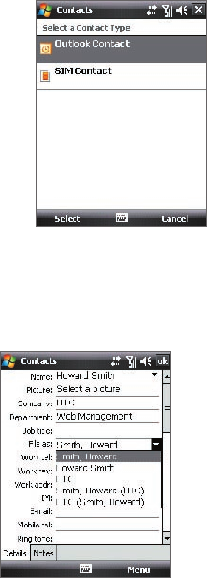
98 Organizing Contacts, Appointments, Tasks, and Other Information
6.1 Contacts
Contacts is your address book and information storage for the people and
businesses you communicate with. You can create the following types of
contacts on your device:
There are three types of contacts that you can create on your device:
• Outlook contacts. Contacts that are
stored on your device, which can be
created on your device or synchronized
with your PC or the Exchange Server.
• SIM contacts. Contacts that are stored
on the SIM card. Only the name and a
phone number can be stored for each
entry.
• Windows Live contacts. Contacts that
you communicate with using Windows
Live Messenger or MSN. Just like Outlook
contacts, you can also enter complete
information for a Windows Live contact.
For more information, see “Add Windows
Live contacts” in Chapter 10.
Note You can only add Windows Live contacts after you have set up Windows
Live on your device.
Add new contacts
To add a contact on your device
1. Tap Start > Contacts.
2. Tap New, select Outlook
Contact, and enter the contact
information.
3. In the File as field, choose how
you want the contact name to
appear in the contact list.
Organizing Contacts, Appointments, Tasks, and Other Information 99
4. To add a photo of the contact, tap Select a picture, then select
the picture file or tap Camera to take a photo of the contact. This
photo appears on the Phone screen when you receive a call from the
contact.
5. To assign a ring tone to the contact, tap the Ring tone field, scroll
through the list of tones, then select a desired tone.
6. When finished, tap OK.
Tips • If someone who is not in your list of contacts calls you, you can create a
contact from Call History by tapping and holding a phone number and
then tapping Save to Contacts from the shortcut menu.
• To save a phone number that is contained in a message, tap the phone
number, then tap Menu > Save to Contacts.
• To edit contact information, tap the contact name then tap Menu > Edit.
To add a contact to your SIM card
1. Tap Start > Contacts.
2. Tap New then select SIM Contact.
3. Enter a contact name and phone number.
4. Tap OK.
Tip You can also use the SIM Manager to add and edit contacts on your SIM card.
For more information, see "SIM Manager" later in this chapter.
View, organize and search
To view contact information
1. Tap Start > Contacts.
2. Slide your finger upward on the touch screen to scroll down the
contact list.
To scroll up the contact list, slide your finger downward on the touch
screen.
Note For detailed instructions on how to use finger scrolling, see "Finger
scrolling and finger panning" in Chapter 1.
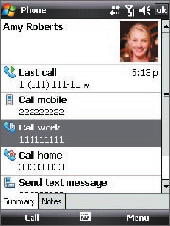
100 Organizing Contacts, Appointments, Tasks, and Other Information
3. Touch the name of a contact to
open his or her contact card.
4. On the contact card, you will see
the last outgoing or incoming call
as well as detailed information such
as phone numbers of the contact,
e-mail address, and more.
To group similar contacts
You can group similar contacts for easier management by assigning them
to categories.
1. Create a new Outlook contact or edit an existing Outlook contact.
2. Tap Categories.
3. Select a preset category such as Business or Personal, or tap New to
create your own category.
4. When finished, tap OK.
To view contacts by category
• Tap Menu > Filter then select the desired category.
To find a contact on your device
There are several ways to find a contact when your contact list is long.
1. Tap Start > Contacts.
2. Do one of the following:
• On the Quick Scroll bar on the right of the screen (black vertical
bar), scroll to or touch a letter to go directly to the part of the
Contacts list where contact names start with that letter.
Note You can disable the Quick Scroll bar by tapping Menu > Options and
selecting the Show alphabetical index check box. This will show the
alphabetical index on top of the Contacts list.
Organizing Contacts, Appointments, Tasks, and Other Information 101
• Begin entering a contact name in the provided text box until the
contact you want is displayed.
• Filter the list by categories. In the contact list, tap Menu > Filter,
then tap a category you’ve assigned to a contact. To show all
contacts again, select All Contacts.
Share contact information
To beam a contact’s details
You can quickly send contact information to another mobile phone or
device through Bluetooth beaming.
1. Tap Start > Contacts, then select a contact.
2. Tap Menu > Send Contact > Beam then select a device where to
beam the contact to.
Note Before you can beam, make sure Bluetooth is turned on and set to visible
mode on your device and the target mobile device. You can also beam
contact information to your PC. See "Bluetooth" in Chapter 10 for details.
To send contact information via text messaging
1. Tap Start > Contacts, then select a contact.
2. Tap Menu > Send Contact > SMS \ MMS.
3. Select the contact information you want to send, then tap Done.
4. In the new text message, enter the mobile phone number of the
recipient, then tap Send.
To send contact information as a vCard
A vCard (virtual business card) is a standard file format used for exchanging
contact information. vCard files can be exported to Outlook on the PC. From
your device, you can send a vCard containing contact information as a file
attachment in an MMS message.
1. Tap Start > Contacts, then select a contact.
2. Tap Menu > Send as vCard.
3. A new MMS message is created with the vcard file attached. Enter
the mobile phone number or e-mail address of the recipient then tap
Send.
102 Organizing Contacts, Appointments, Tasks, and Other Information
6.2 SIM Manager
SIM Manager allows you to view the contents of your SIM card, transfer
contacts from your SIM card to your device or vice versa, and make a call to
a SIM contact.
To create a contact on your SIM card
1. Tap Start > Programs > SIM Manager.
2. Tap New and enter a contact name and phone number.
3. Tap Save to save the information on your SIM card.
Tip: To change contact information on your SIM card, tap a SIM contact and edit
it. After modifying, tap Save.
To copy SIM contacts to your device
If you have saved contacts on your SIM card, you can copy them into
Contacts on your device.
1. Tap Start > Programs > SIM Manager.
2. Select the desired item, or select all SIM contacts by tapping Menu >
Select All.
3. Tap Menu > Save to Contacts.
To copy contacts to the SIM card
Only one phone number per contact name can be stored on a SIM card.
When you copy a contact that has several phone numbers to your SIM card,
SIM Manager saves each number under a separate name.
To save each number under a different contact name on the SIM card, SIM
Manager appends an indicator at the end of each name. By default, /M, /W
and /H are appended to indicate mobile, work and home phone numbers
respectively. You can edit this indicator first before you start copying
contacts to your SIM card. Indicators of the other types of phone numbers
are left empty for you to define them.
1. Tap Start > Programs > SIM Manager, then tap Menu > Tools >
Options.
2. Select the check boxes of the types of phone numbers that you want
to be added to the SIM card.
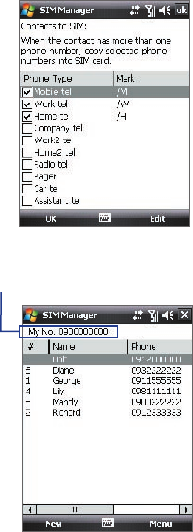
Organizing Contacts, Appointments, Tasks, and Other Information 103
3. Under the Mark column, you can
change the indicator that will be
appended to the SIM contact names
for each phone number type. To do
so, select a phone type, tap Edit, enter
your desired indicator, then tap Save.
4. After modifying, tap OK.
5. Tap Menu > Contacts to SIM.
6. Select the check boxes of the contact’s
phone numbers that you want to
copy to your SIM card, then tap Save.
To store your SIM card’s phone
number
1. On the SIM Manager screen, tap
Menu > Tools > List of Own
Numbers.
2. Tap [Voice Line 1].
3. Change the name, if desired,
then enter your mobile phone
number.
4. Tap Save.
When your phone number is stored on
the SIM card, it will appear on the SIM
Manager screen.
104 Organizing Contacts, Appointments, Tasks, and Other Information
6.3 Calendar
Use Calendar to create appointments, including meetings and other
events. You can also synchronize Calendar appointments between your
device and PC.
Create appointments
To schedule an appointment
1. Tap Start > Calendar.
2. Tap Menu > New Appointment.
3. Enter a name for the appointment.
4. Do one of the following:
• If it is a special occasion such as a birthday or a whole-day event,
set the All Day option to Yes.
• If there is a time frame for the appointment, select the start and
end dates and time.
5. Specify the type of category for your appointment, so that it can be
grouped with other related appointments. Tap Categories, then
select a preset category (Business, Holiday, Personal, or Seasonal), or
tap New to create your own category.
6. When finished, tap OK to return to the calendar.
Notes • All-day events do not occupy blocks of time in Calendar; instead, they
appear in banners at the top of the calendar.
• To cancel an appointment, tap Menu > Delete Appointment.
Tip To have the time entered automatically in Day view, tap the time slot for the
new appointment, and tap Menu > New Appointment.
To set a default reminder for all new appointments
You can have a reminder automatically turned on for all new appointments
you schedule.
1. Tap Start > Calendar.
2. Tap Menu > Tools > Options > Appointments tab.
3. Select the Set reminders for new items check box.
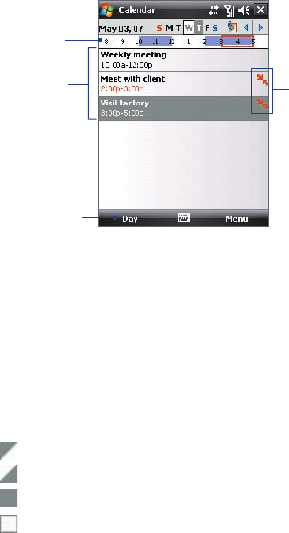
Organizing Contacts, Appointments, Tasks, and Other Information 105
4. Set the time when you want the reminder to alert you.
5. Tap OK to return to the calendar.
View appointments
By default, Calendar displays appointments in Agenda view. You can also
look at your appointments in Day, Week, Month, and Year views.
The highlighted hours
here indicate the time of
your appointments.
Tap to view appointment
details.
Agenda view
Tap to switch views.
Indicates
that there
is a conflict
with another
appointment.
• To see detailed appointment information in any view, tap the
appointment.
• To view appointments by category, tap Menu > Filter then select the
desired category.
• To change the default view that Calendar uses to display
appointments, tap Menu > Tools > Options > General tab. Tap the
Start in box then choose the calendar view.
• When in Month view, you will see the following indicators:
Morning appointment
Afternoon or evening appointment
Both morning and afternoon/evening appointments
All-day event
106 Organizing Contacts, Appointments, Tasks, and Other Information
Send appointments
To send a meeting request
Use Calendar to schedule meetings via e-mail with contacts who use
Outlook or Outlook Mobile.
1. Tap Start > Calendar.
2. Schedule a new appointment, or open an existing one and tap Edit.
3. Tap Attendees, then tap Add Required Attendee or Add Optional
Attendee and add the contacts whom you want to invite.
Note You can specify if an attendee is required or optional only if your
device is connected to a Microsoft Exchange 2007 server. Otherwise,
all attendees are designated as required. For more information, see
Chapter 8.
4. When have finished adding attendees, tap Done.
5. Tap OK to send.
Tip To choose the e-mail account to use for sending meeting requests, tap
Menu > Tools > Options > Appointments tab. Tap the Send meeting
requests via box and choose to send via your Outlook E-mail, POP3/IMAP4
or Windows Live account.
Notes • If you’re sending the meeting request using your Outlook E-mail account,
it will be sent to the attendees the next time you synchronize your device
with your PC or Exchange Server.
• When attendees accept your meeting request, the meeting is
automatically added to their schedules. When their response is sent back
to you, your calendar is updated as well.
To send appointment details as a vCalendar
A vCalendar is a standard file format used for exchanging scheduling and
task information. vCalendar files can be exported to Outlook on the PC.
Tap Menu > Send as vCalendar to send a vCalendar containing
appointment details as a file attachment in an message. For more
information, see “MMS” in Chapter 7.
Organizing Contacts, Appointments, Tasks, and Other Information 107
6.4 Tasks
Use Tasks to keep track of things you need to do. A task can occur once or
repeatedly (recurring). You can set reminders for your tasks and you can
organize them using categories.
Your tasks are displayed in a task list. Overdue tasks are displayed in red.
To create a task
1. Tap Start > Programs > Tasks.
2. Tap Menu > New Task, enter a subject for the task, and fill in
information such as start and due dates, priority, and so on.
3. Specify the type of category for your task, so that it can be grouped
with other related tasks. Tap Categories, then select a preset category
(Business, Holiday, Personal, or Seasonal), or tap New to create your
own category.
4. When finished, tap OK.
Tip You can easily create a short, to-do type task. Simply tap the Tap here to add
a new task box, enter a subject, and tap the Enter button on the onscreen
keyboard. If the task entry box is not available, tap Menu > Options and
select the Show Tasks entry bar check box.
To change the priority of a task
Before you can sort tasks by priority, you need to specify a priority level for
each task.
1. Tap Start > Programs > Tasks.
2. Tap the task you want to change the priority for.
3. Tap Edit, and in the Priority box, tap a priority level.
4. Tap OK to return to the task list.
Note All new tasks are assigned a Normal priority by default.
108 Organizing Contacts, Appointments, Tasks, and Other Information
To set a default reminder for all new tasks
1. Tap Start > Programs > Tasks.
2. Tap Menu > Options.
3. Select the Set reminders for new items check box.
4. Tap OK to return to the task list.
Note The new tasks must have due dates set in order for the reminder to take
effect.
To show start and due dates in the task list
1. Tap Start > Programs > Tasks.
2. Tap Menu > Options.
3. Select the Show start and due dates check box.
4. Tap OK.
To locate a task
When your list of tasks is long, you can display a subset of the tasks or sort
the list to quickly find a specific task.
1. Tap Start > Programs > Tasks.
2. In the task list, do one of the following:
• Sort the list. Tap Menu > Sort By, and tap a sort option.
• Filter the list by category. Tap Menu > Filter, and tap the category
you want displayed.
Tip To filter your tasks further, tap Menu > Filter > Active Tasks or Completed
Tasks.
To send task information as a vCalendar
Tap Menu > Send as vCalendar to send a vCalendar containing task details
as a file attachment in an MMS message. For more information, see “MMS”
in Chapter 7.
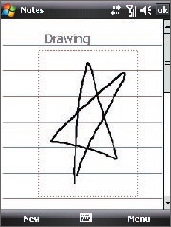
Organizing Contacts, Appointments, Tasks, and Other Information 109
6.5 Notes
Using Notes, you can create handwritten and typed notes, record voice
notes, convert handwritten notes to text for easy readability, and more.
To create a note
1. Tap Start > Programs > Notes. In the note list, tap New.
2. Tap the Input Selector arrow next to the Input Method icon on the
menu bar, tap the input method you want, and enter your text.
3. If the Input Selector arrow is not displayed, tap the Input Method
icon.
4. When finished, tap OK to return to the note list.
Notes • To select handwritten text, tap and hold next to the writing. As soon as
dots appear, and before they form a complete circle, quickly drag across
the writing.
• If a letter crosses three ruled lines, it is treated as a drawing rather than
text.
To draw in a note
1. Tap Start > Programs > Notes.
2. In the note list, tap New.
3. To draw on the screen, use the stylus
like a pen.
4. A selection box appears around your
drawing.
5. When finished, tap OK to return to the
note list.
Note To select a drawing (for example, to copy
or delete it), tap and hold the drawing
briefly. When you lift the stylus, the
drawing is selected.

110 Organizing Contacts, Appointments, Tasks, and Other Information
To record a voice note
You can create a stand-alone recording (voice note) or you can add a
recording to a note.
1. Tap Start > Programs > Notes.
2. Do one of the following:
• To create a stand-alone recording, record from the note list.
• To add a recording to a note, create or open a note.
3. If you do not see the Recording toolbar, tap Menu > View Recording
Toolbar.
4. Tap the Record icon ( ) to begin recording your voice. Tap the
Stop icon ( ) when finished recording.
To change recording formats
1. Tap Start > Settings > Personal tab > Input.
2. Tap the Options tab, and select the desired format you want in the
Voice recording format list.
3. Tap OK.
Note
You can also change recording formats from within Notes. In the note list, tap
Menu > Options > Global Input Options link (at the bottom of the page),
then tap the Options tab.

Organizing Contacts, Appointments, Tasks, and Other Information 111
6.6 Voice Recorder
Voice Recorder lets you record your voice and then quickly send it in an
MMS or e-mail, beam it, or set the recorded voice as your ringtone.
Note
Voice Recorder saves voice recordings in AMR-NB (Adaptive Multi-Rate
Narrowband) format only. This is a common speech audio format used in
mobile devices.
To record your voice
1. Tap Start > Programs > Voice Recorder.
2. Hold the device’s microphone near your mouth.
3. Tap Record or to start recording a voice clip. Tap Stop to end the
recording.
All recordings are saved in the My Voices folder by default. You can choose
another folder to save voice recordings by tapping beside the folder name
on the top-left of the screen and then in the menu, choose the folder where
to save future recordings.
To play back a voice recording
• On the Voice Recorder screen, select a voice recording then tap .
Tips • Tap to increase the volume; tap to decrease the volume.
• Tap to toggle between muting and unmuting the volume.
To send the voice recording through MMS
• Select a voice recording then tap Menu > Send via MMS. A new
MMS message is then created with the voice recording automatically
inserted as an audio clip.
See “MMS” in Chapter 7 to learn how to compose and send MMS
messages.
To send the voice recording via e-mail
• Select a voice recording then tap Menu > Send > Outlook E-mail.
This creates a new Outlook e-mail message with the voice recording
inserted as a file attachment.
See “Using E-mail” in Chapter 7 to learn how to send e-mail.
112 Organizing Contacts, Appointments, Tasks, and Other Information
To beam the voice recording
1. Select the voice recording(s) you want to beam then tap Menu >
Beam File.
2. Tap the device you want to send the voice recording(s) to.
3. On the other device, accept the file transfer to receive the file.
To set the voice recording as a ring tone
• Select the desired voice recording the tap Menu > Set as Ringtone.
To rename or move a recording
1. Select a voice recording then tap Menu > Rename/Move.
2. Enter the new Name for the voice recording.
3. To move the voice recording, select the new destination Folder and
Location.
4. Tap OK.

Chapter 7
Exchanging Messages
7.1 Messaging
7.2 Text Messages
7.3 MMS
7.4 Types of E-mail Accounts
7.5 E-mail Setup Wizard
7.6 Using E-mail
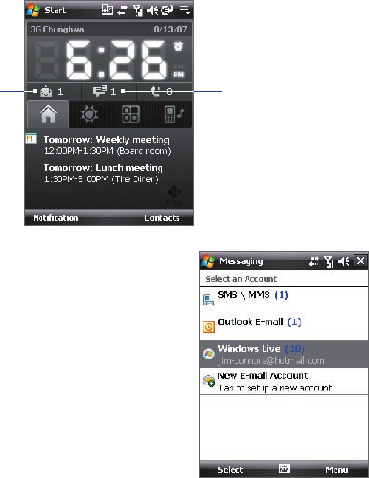
114 Exchanging Messages
7.1 Messaging
Messaging is where your text messages (SMS), multimedia messages
(MMS), and e-mails are located. When you receive new messages, you can
open them from the Today screen. Simply tap the type of message that you
want to open.
New e-mail messages New SMS and MMS
messages
To select a messaging account
Do one of the following:
• Tap Start > Messaging. The
Account Picker screen then appears
where you can select an account.
• While you are in a message list of a
certain account, for example Text/
Multimedia, tap Menu > Go To to
switch to other types of messaging
accounts.
To configure message account settings
• Tap Menu > Options on the
Account Picker screen; or
• Tap Menu > Tools > Options while
you’re in a message list.
Account Picker screen
Exchanging Messages 115
To automatically add a signature in outgoing messages
You can automatically add your name and other information as your
signature in outgoing SMS, MMS and e-mail messages by following these
steps:
Tip You need to specify your signature for each type of messaging accounts.
1. Tap Start > Messaging, then tap Menu > Options.
2. Tap Signatures.
3. Select a type of messaging account in which to add a signature.
4. Select the Use signature with this account check box.
5. In the provided text box, enter the information that will be displayed
as your signature.
6. If you want the signature to be added whenever you reply or forward
messages, select the Use when replying and forwarding check box.
7. Repeat steps 3 to 6 to add a signature to the other types of messaging
accounts.
7.2 Text Messages
Send short text messages (SMS) up to 160 characters long to other mobile
phones.
Send text messages
To compose and send a text message
1. Tap Start > Contacts.
2. Slide your finger upward on the touch screen to scroll down the
contact list. See “Finger scrolling and finger panning” in Chapter 1 for
more details on finger scrolling.
3. Touch the contact’s name to open his or her contact card.
4. On the contact card, touch the item that shows Send text message.
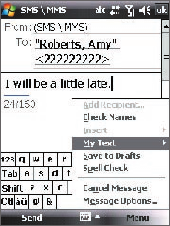
116 Exchanging Messages
5. A new text message is then created.
To add more recipients,
enter their mobile
phone numbers in the To field, separating
them with a semicolon. You can also
tap To if you want to add mobile phone
numbers from Contacts.
6. Enter your message.
•
To quickly add common messages,
tap Menu > My Text and tap a desired
message.
• To check the spelling, tap Menu >
Spell Check.
7. Tap Send.
Tips • To enter symbols, tap Shift using the onscreen keyboard then tap a
symbol. For more information about entering text and symbols, see
Chapter 2.
• If you want to know when a text message is received, before sending the
message that you are composing, tap Menu > Message Options then
select the Request message delivery notification check box.
To always receive a delivery notification, tap Menu > Tools > Options in
the text message list, tap SMS \ MMS, then select the Request delivery
notifications check box.
Copy text messages from and to the SIM card
1. Tap Start > Messaging > SMS \ MMS.
2. In the message list, select the text message you want to copy.
3. Do one of the following:
• To copy a text message to the SIM card, tap Menu > Copy to SIM.
• To copy a text message from the SIM card to your device, tap
Menu > Copy to Phone.
Note Text messages stored on your SIM card are automatically displayed in the
Inbox folder. Copying them to your device results in duplicate messages in
the Inbox folder when your SIM card is in use.
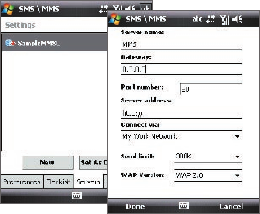
Exchanging Messages 117
7.3 MMS
Sending multimedia messages (MMS) to your friends and family is fun and
easy. You can include pictures, video, and an audio clip in a multimedia
message.
Notes • Please note that multimedia messaging is a charged service and has to be
provisioned on your mobile account. Please contact your wireless service
provider to have MMS provisioned as part of your calling plan.
• Please make sure the size of MMS messages that you send is within the
limits allowed by your wireless service provider.
Change MMS settings
Check your device to see if it is configured with your wireless service
provider’s MMS settings. If the MMS settings are not yet configured on your
device, you can add the settings while composing an MMS message.
To configure MMS message settings
1. Tap Start > Messaging > SMS \ MMS.
2. Tap Menu > MMS Options. The Settings screen then appears.
4. In the Preferences tab, select or clear the provided check boxes
according to your needs.
5. Tap the Servers tab and
check if your device is
preset with MMS server
settings.
If there are no preset
settings, tap New and
enter the following
information, which you
can get from your other
wireless service provider:
• Gateway. Location of the MMS server, which is usually in the form
of an IP address.

118 Exchanging Messages
• Port number. HTTP port number used for connecting to the MMS
server and for file transfer.
• Server address. URL address of the server where MMS messages
are stored.
• Connect via. Select the connection that your device uses for MMS
messages.
• Sending size limitation. Select the maximum MMS message size
allowed by your wireless service provider.
• WAP version. Select either WAP 1.2 or WAP 2.0, depending on
which one is being used by your other wireless service provider.
6. Tap Done.
Note • If your device already has preset MMS settings, it is recommended that
you do not change these settings. If you change the preset settings, your
device may not be able to send and receive MMS messages.
• If you add several MMS message service providers to the Settings screen,
you can choose one as your default provider. Select the provider's name
in the list then tap Set As Default.
Create and send MMS messages
You can compose MMS messages in a combination of slides, where each
slide can consist of a photo, video or audio clip, and/or text.
To compose an MMS message
1. Tap Start > Messaging > SMS \ MMS, then tap Menu > New > MMS.
2. When you see the Choose a MMS screen, tap a preset template, or tap
Custom to open a blank MMS message.
Note If you prefer to always create a blank MMS message, select the Always
choose custom check box.
3. In To, enter the recipient’s phone number or e-mail address directly,
or tap To, Cc, or Bcc to choose a phone number or an e-mail address
from Contacts.
Note Scroll up to see the Cc and Bcc fields.
4. Enter a subject for your message.
5. Tap the Insert icon ( ) to select and insert a photo or video clip.
When selecting a photo or video clip, you can:
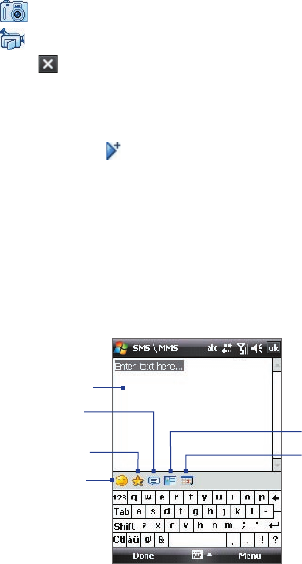
Exchanging Messages 119
• Tap Select to insert the selected photo or video clip into the MMS
message you are composing.
• Tap to take a photo and insert it into the MMS message.
• Tap to record MMS video and insert it into the MMS message.
• Tap Exit ( ) to quit selection and return to the MMS message.
6. Enter text and insert audio clips by tapping the respective areas. See
“To add text to an MMS message” and “To add an audio clip to a MMS
message” for details.
7. To add more slides, tap or tap Menu > Slides > Insert Slide. Repeat
steps 5 and 6 to insert photos/videos, text, and audio onto your slides.
8. Tap Send to send the MMS message.
Tip You can also send an MMS message from the Pictures & Videos, Camera
program, or Camera Album.
To add text to an MMS message
When you tap Insert text here on your MMS message, an empty screen
appears where you can enter your text. You can insert the following types of
information:
Enter your own text
Choose from common words
or phrases from the My Text list
Include a Favorites link
Add an emoticon
Insert contact
information
Insert calendar
appointment
Tip To edit or delete a phrase on the My Text list, tap and hold a string, then tap
Edit or Delete from the shortcut menu. To add a new phrase, tap New.
To add an audio clip to an MMS message
You can add one audio clip per slide in your MMS message.
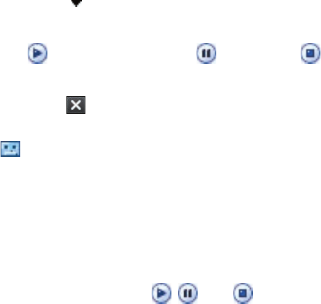
120 Exchanging Messages
1. Tap Insert audio.
By default, My Documents will be shown. Tap My Music or another
folder that contains audio files. When navigating folders, tap the
Down arrow ( ) to return to the upper folder.
2. Select an audio file. When selected, you can:
• Tap to play the audio clip, to pause, or to stop playback.
• Tap Select to insert it into your MMS message.
• Tap Exit ( ) to quit selection and return to your MMS message.
• To record a new audio clip and add it to your MMS message, tap
. The Record pop-up window then opens. Tap Record to start
recording, and Stop to end the recording. Tap Play to listen to
the recorded audio clip, then tap Add. The new audio clip is then
inserted into your MMS message.
View and reply MMS messages
To view an MMS message
• Use the playback controls , , and .
• Tap Contents to see a list of files included in the message. On the
Message Contents screen, you can do the following:
• To save a file, select it, and tap Menu > Save.
• To save the contents of a text file to the My Text list, tap Menu >
Save into My Text.
• To associate a photo to one of your contacts, tap Menu > Assign
to Contact.
To reply to an MMS message
• Tap Menu > Reply to reply to the sender of the message; or
• Tap Menu > Reply All to reply to all persons listed in To, Cc, and Bcc
of the message.
To block a phone number from sending you MMS messages
If you do not want to receive MMS messages from a particular sender, you
can add the sender’s phone number to the MMS Blacklist.